Phase 3 of Grassland Restoration Project - 2014
Phase 3 – April 2014 through Spring 2015
- Fields did not need to be mowed since the rye had very little growth.
- Fields were disked:
- April 19,20 and 21
- May 29 & 30
- Mile-a-Minute hand pulled by STRIKE Team
- June 28
- July 26
- August 7
- September 10
- September 19
- August 13, 2014 – rainstorm delivers 12 inches of rain and causes heavy erosion in parts of field 3.
- Prepare fields for planting of winter crop of rye
- Plant rye – October 2014
- Mow rye and prepare to plant native grasses and forbs – Spring 2015
Details of Phase 3
Discing to Remove Invasives:
The Caumsett Foundation contracted Andrew Gladyzs, a farmer from Rocky Point, Long Island, New York to complete Phase 3 of the restoration project. This phase included discing all fields to remove invasive vegetation during the growing season and planting a winter crop of rye in the fall. The fields were generally disced generally once a month. During monthly discing the number of days needed to till the field was dependent on vegetation growth. Initially more time was required due to heavier plant cover. In April the fields were disced 3 days in a row. The month of May required 2 consecutive days of discing, in contrast June, July and August required only one day of discing. The last discing occurred in September prior to planting the winter rye crop.
Growing Season:
Plant emergence changed as the growing season progressed. The dominant plants during the month of May were Winter rye and mustard (Barbarea sp). During June and July, Mile-a-Minute (MAM) emerged and rapidly grew. By the end of July and August, Purslane (Portulaca sp) and Horsenettle (Solanum sp) dominated. A vegetation transect was completed on May 28th, 2014 prior to the 2nd discing.
Fields After Final Discing
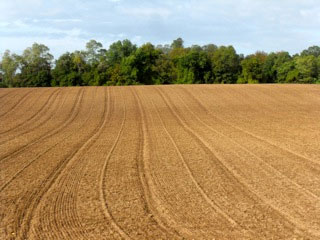
Final product of disced fields at end of 2014 growing season.
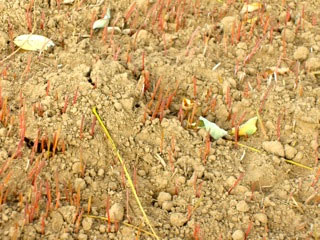
Rye germination on October 14, 2014.
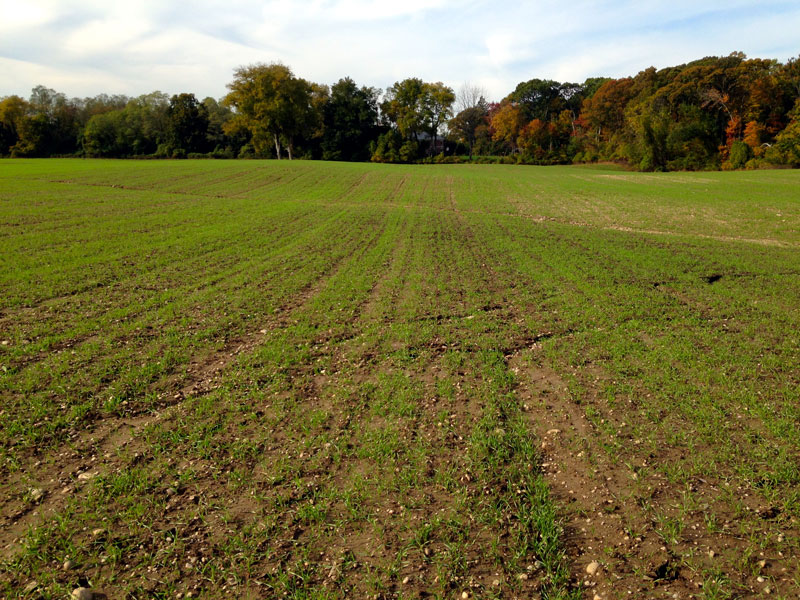
Rye field on October 28, 2014.
Unpredicted Events
Unpredicted events resulted in additional work. The most notable event occurred on August 14th when in less than 8 hours thirteen inches of rain poured down on the Long Island. This heavy rainfall caused significant erosion in field 3 spreading from the Hickory trees in former hedgerow east to the northern border of the field. Field 1 eroded in a north-south direction in its eastern portion. Future rain events resulted in more erosion in field 3. In October the eroded areas were graded and hay bales added in an effort to prevent further erosion.
The loose rocks in field 3 proven to be an impediment to routine discing. The additional job of removing the rocks was added to the project.
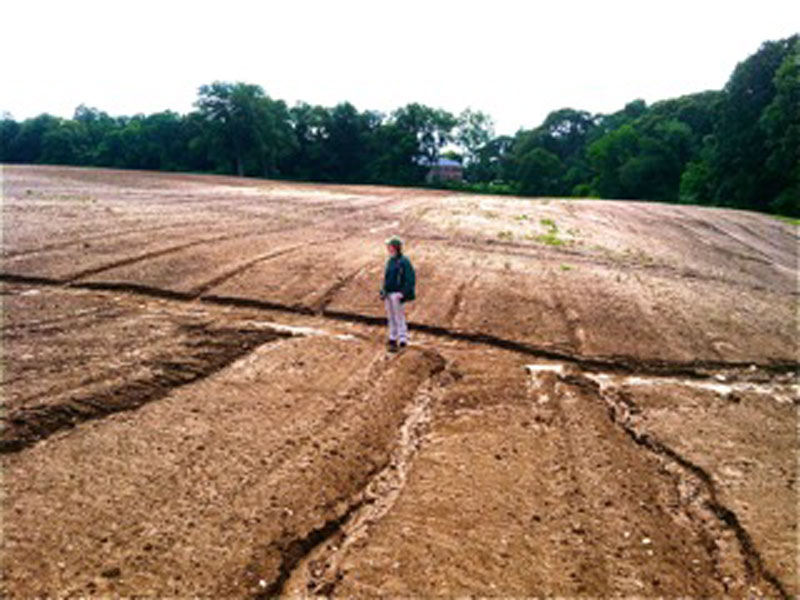
Erosion in Field 3 following August 14th downpour.
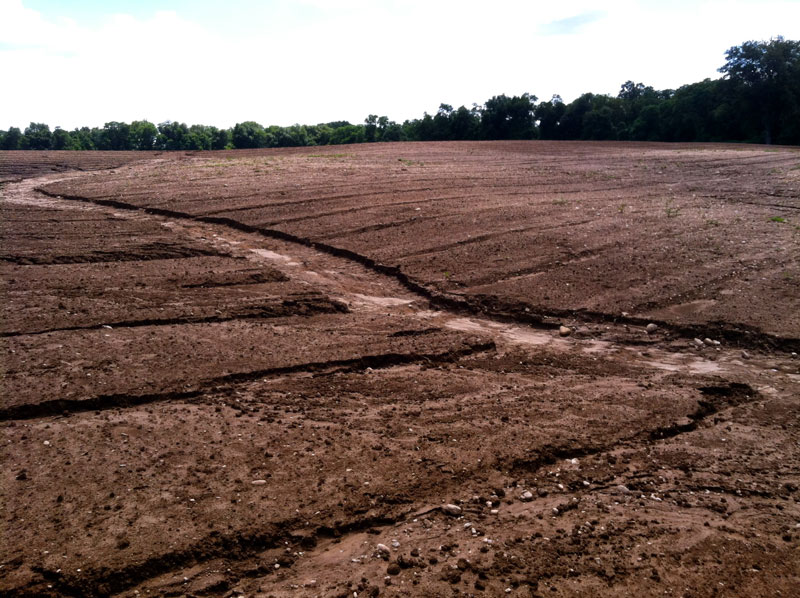
Erosion in Field 3 following August 14th downpour.
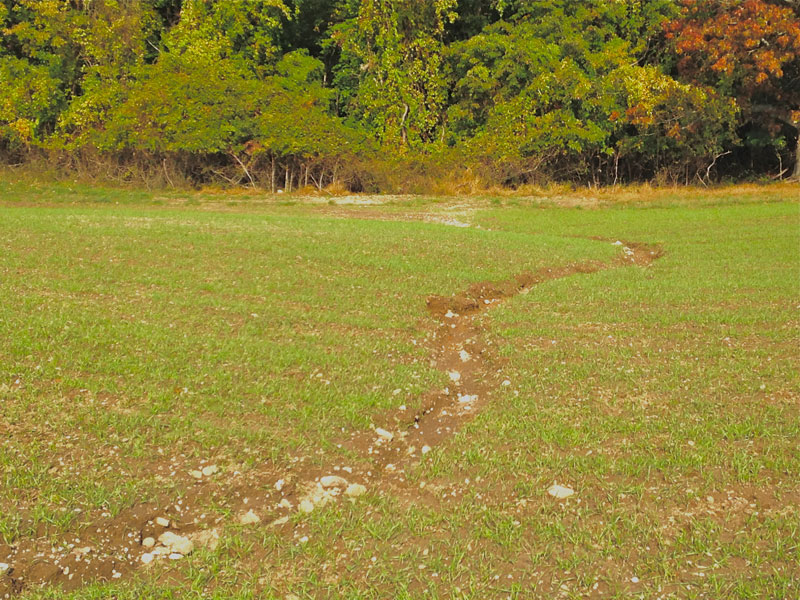
Erosion in Field 3 in October 2014.
Monthly descriptions of Phase 3 are provided below.
APRIL EVENTS
April 19 - 21st Discing
The contractor began discing the fields on April 19th. The winter rye planted in August of 2013 did not have to be mowed prior to discing as there was minimal growth. This outcome may be attributed to the harsh winter and poor early growing season of 2014.
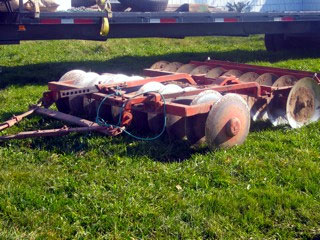
Disc unloaded off of trailer for use in the fields.
MAY EVENTS
May 19 - 22nd Mustard Removal
Volunteers and two NYS Parks summer interns made an intense effort over a period of 5 days to pull the plant Mustard. Mustard was found primarily in field #1 near the eastern boundary and approaching the middle section of the field. The plant was scattered through out the 30 acres but did not heavily infest fields 2 or 3. During the time of these pulls the plant was mostly flowering with a minority going to seed. The pulled plants were placed in black garbage bags and left in the sun to bake for at least one week before being disposed in park garbage container.
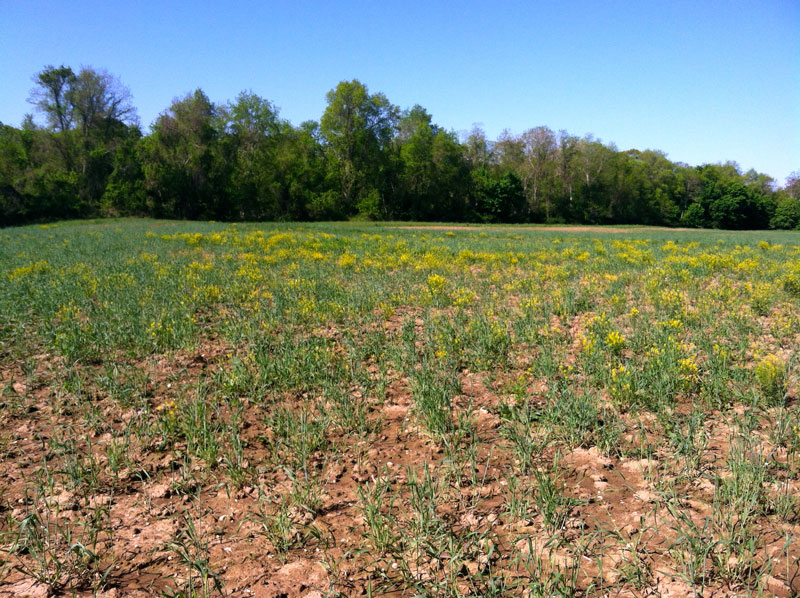
Mustard in Field 1 on May 19, 2014.
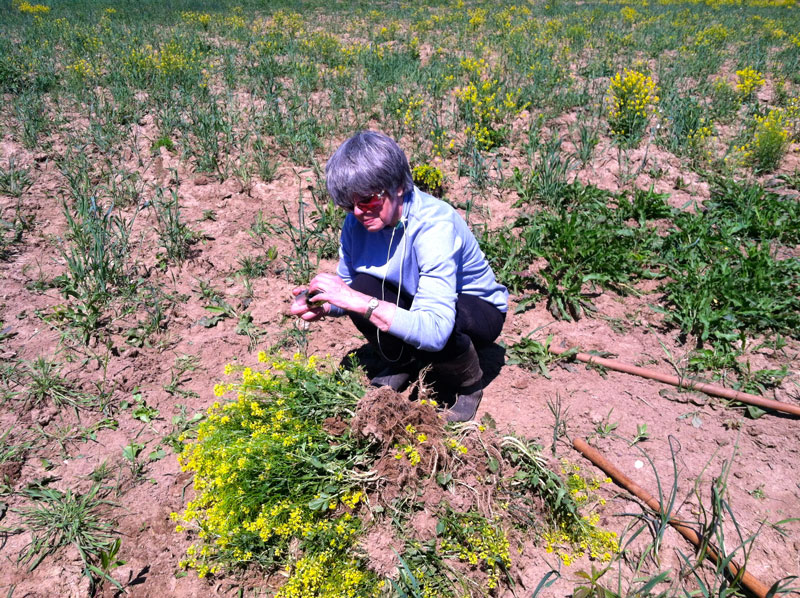
Volunteer pulling out mustard plants.
JUNE EVENTS
June 26th - Mile-a-Minute Removal
Six volunteers including four from Timberland Outlet store in Deer Park, NY pulled MAM around the two Hickory trees located in the former hedgerow. The inability to closely disc vegetation around these trees allowed the MAM to continue to grow. Volunteers took safety precautions to avoid contact with the poison ivy that was growing along the base of the Hickory trees and on the ground.
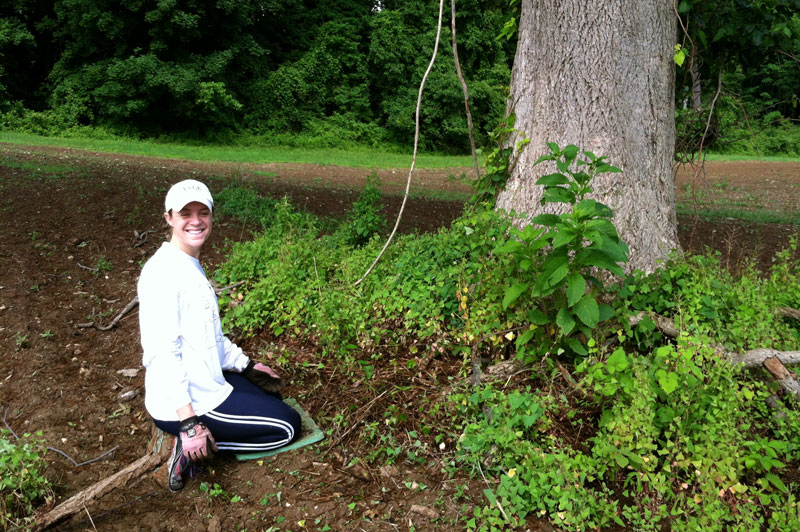
Volunteer pulling MAM around Hickory tree.
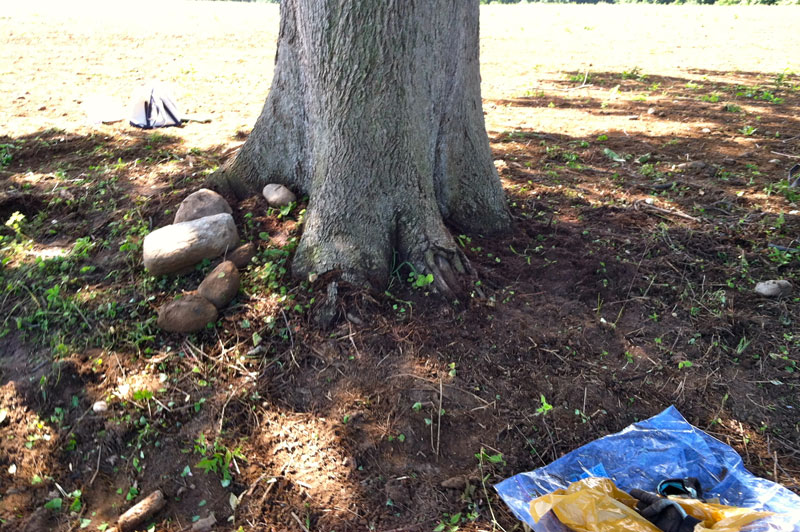
Tree base after MAM was removed.
June 28th DISCING
29 days between discing
Discing was accomplished in one day. Minimal vegetation was missed during the process. Summer interns pulled about 100 MAM plants that the disc had missed.
JULY EVENTS
July 11, 2014
NYS Park's STRIKE team pulled all observed MAM from the entire 30-acre site.
July 26th DISCING
28 days between discing
Disced in one day. Field #1 had sections heavily covered with Purslane but the majority of the field had open soil. Horsenettle was scattered through out the entire 30 acres. Field 3 started showing signs of erosion in the eastern section.
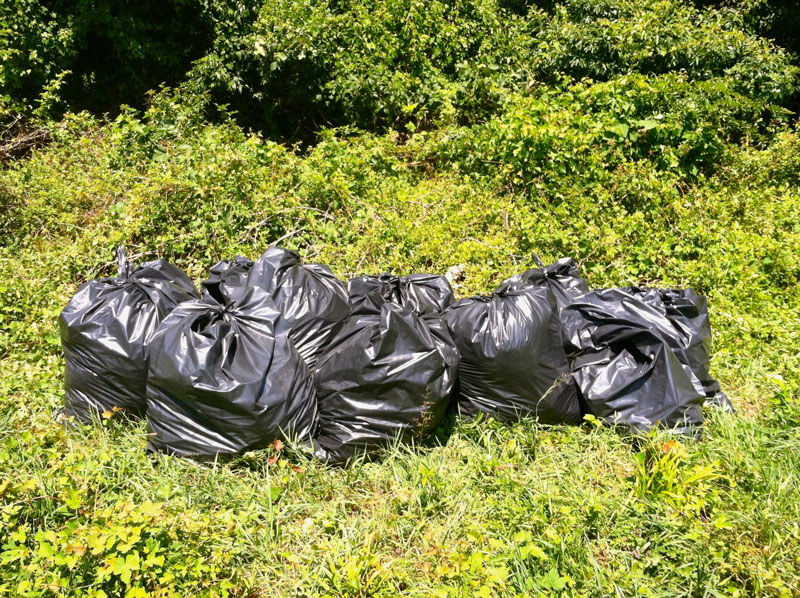
After MAM was pulled it was placed in black plastic bags and left to bake in the sun for several weeks.
Early Fall
August through October 2014
On 14 August thirteen inches of rain fell in 8 hours on Long Island. Prior to this rain event the fields had been disked and were not vegetated. As a result the northern and southeastern sections of the site experienced severe erosion.
Consequently these sections had to be graded prior to planting the winter rye crop.
Bales of hay were placed in areas that continued to experience erosion. This was not a completely successful strategy as erosion in these areas did continue through out the winter and early spring.
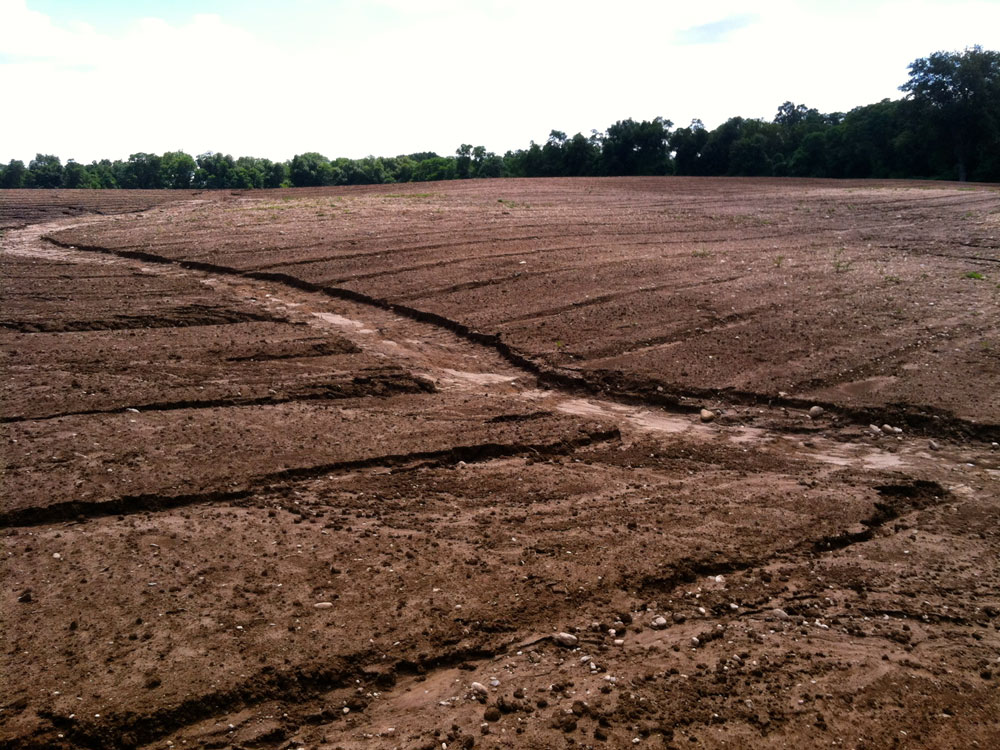
North end of restoration field after the deluge.
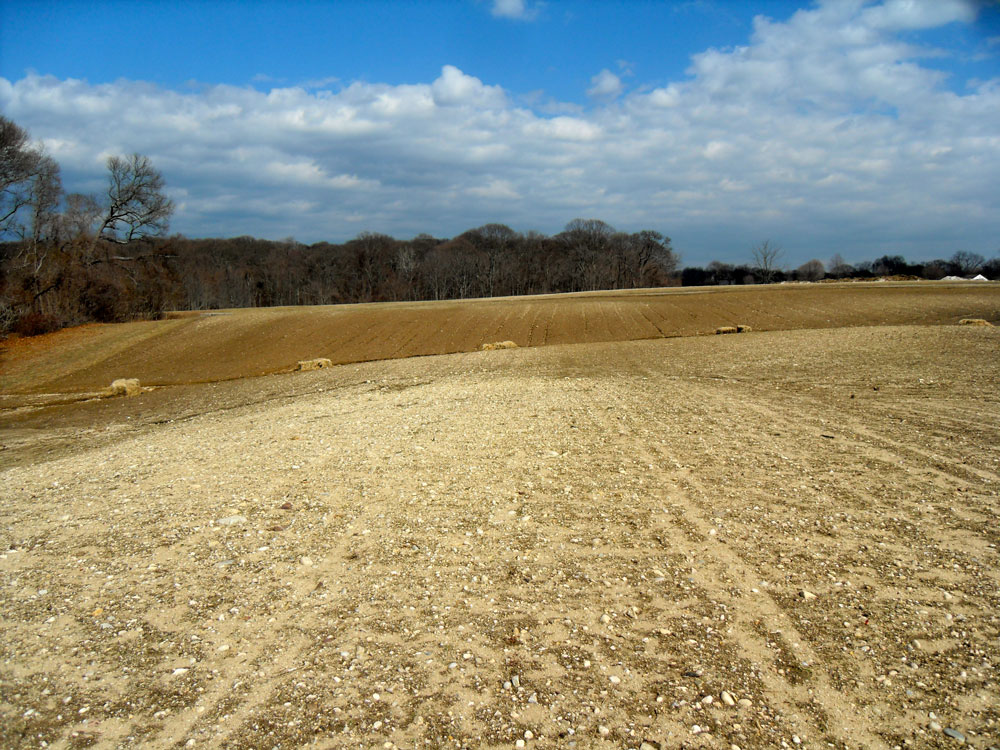
Graded fields prior to rye planting.
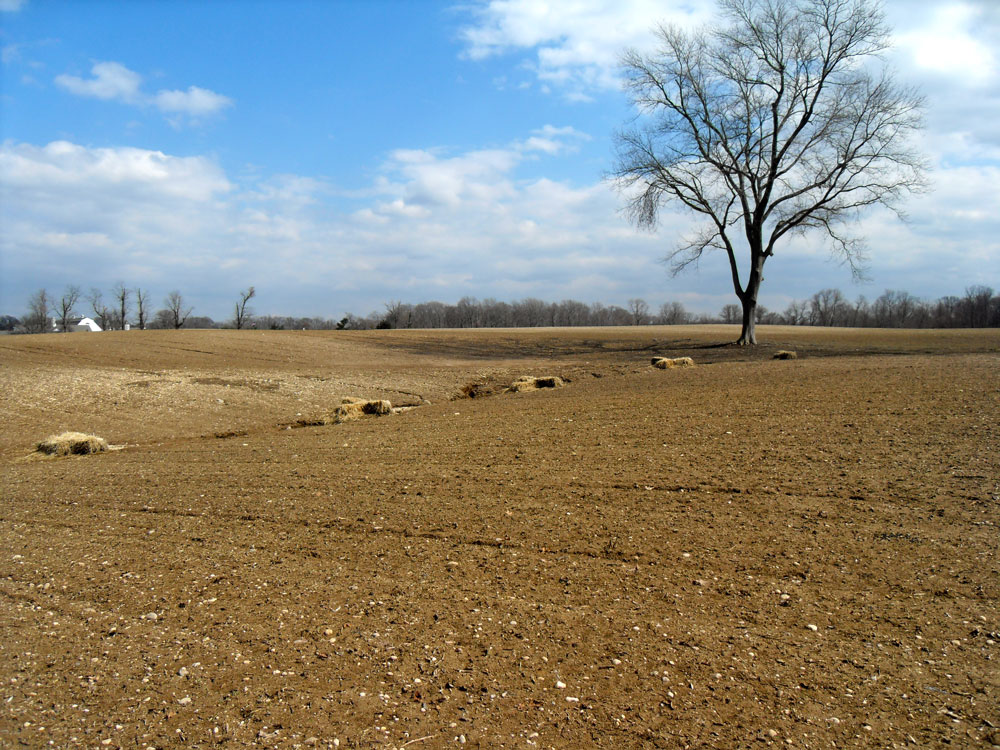
Bales of hay were placed in areas that continued to experience erosion. This was not a completely successful strategy as erosion in these areas did continue through out the winter and early spring.
Winter
The long cold winter of 2014 - 2015
According to National Weather Service’s Upton office, February was the coldest month on record for Long Island (temperature readings are taken at Long Island MacArthur Airport), going back to 1984, when the agency officially began to record data. The average temperature in February was 21.6 degrees.
For the season, the weather service measured 56.6 inches of snow at MacArthur Airport, more than double the historic seasonal average of 24.8 inches.
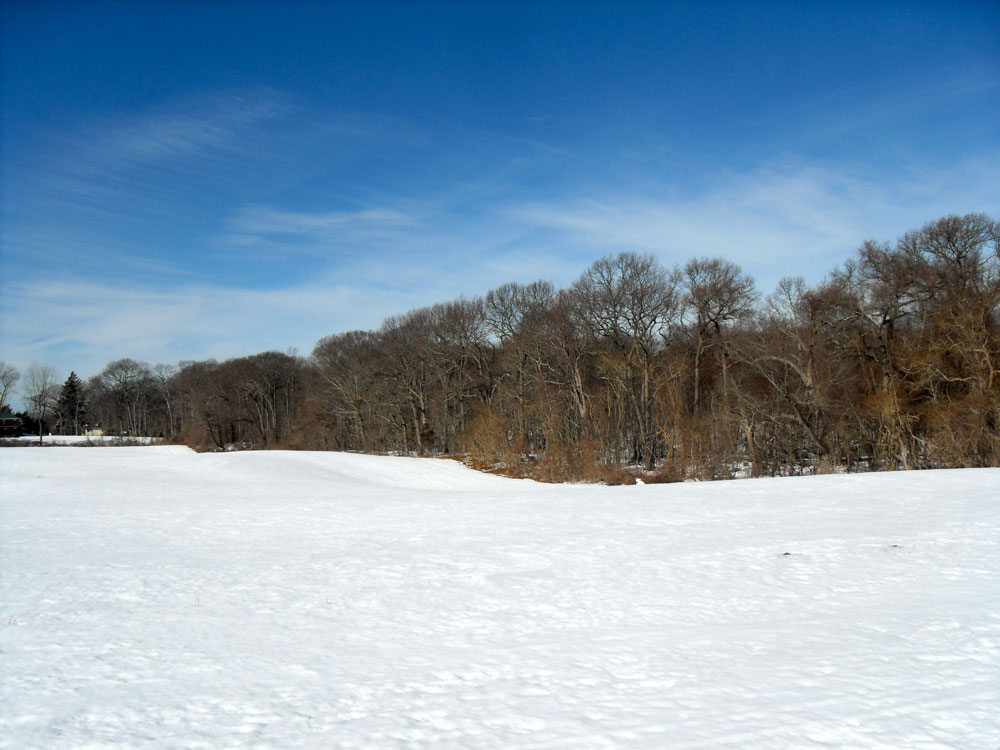
Grasslands covered with snow.
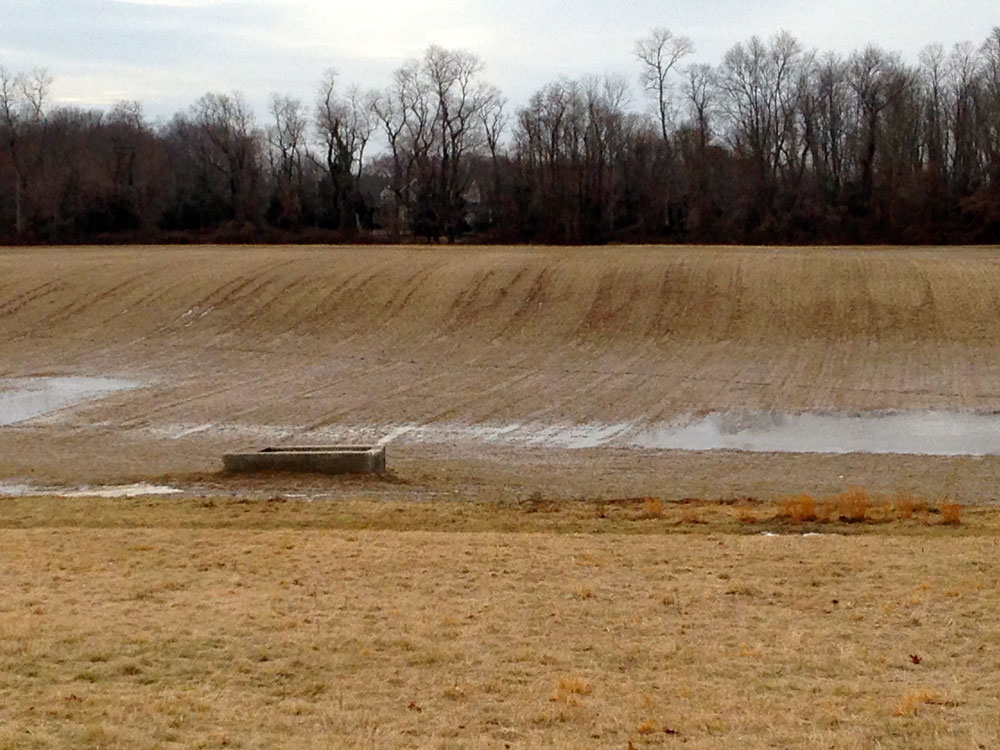
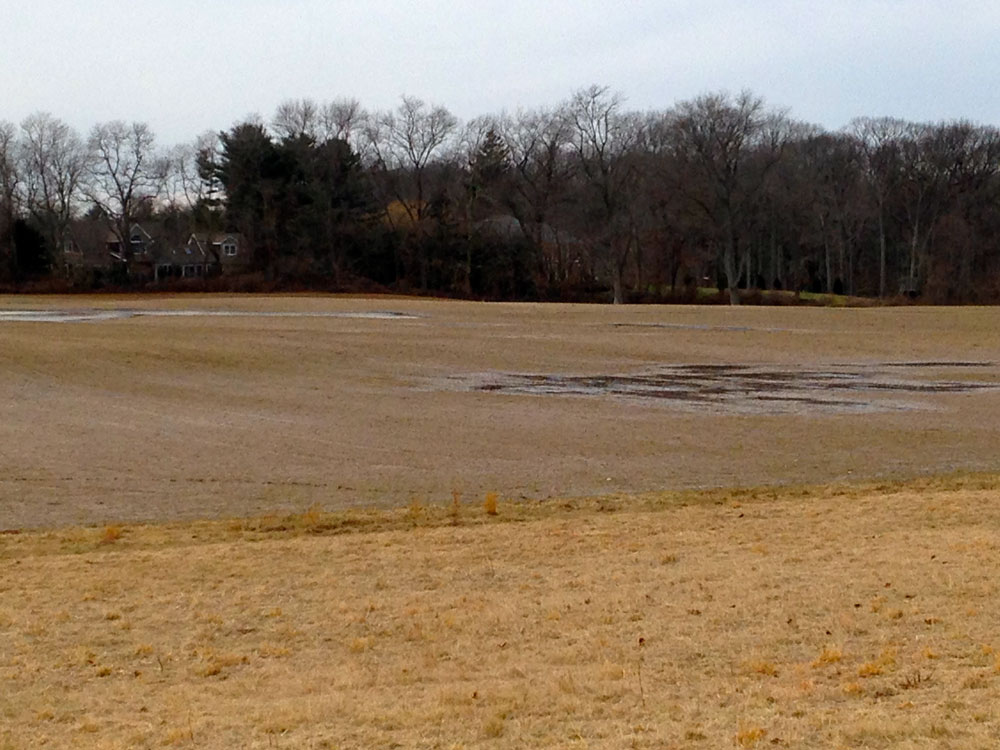
Pools of frozen water appear on the fields in January 2015.
Spring 2015
Mowing, Re-grading and Seeding
A cool late spring with low rainfall amounts initially produced a sparse and short crop of rye. According to Brookhaven National Lab weather station 1.81 inches of rain fell in the month of April and 0.53 inches in May. Significantly below the averages of 4.20 and 3.83 inches respectively.
Even into early May the rye growth was minimal leading us to believe that mowing would not be necessary prior to planting the native seed by the end of the month. All that changed by the second week of May. With warming temperatures the rye came in with robust and mowing was needed.
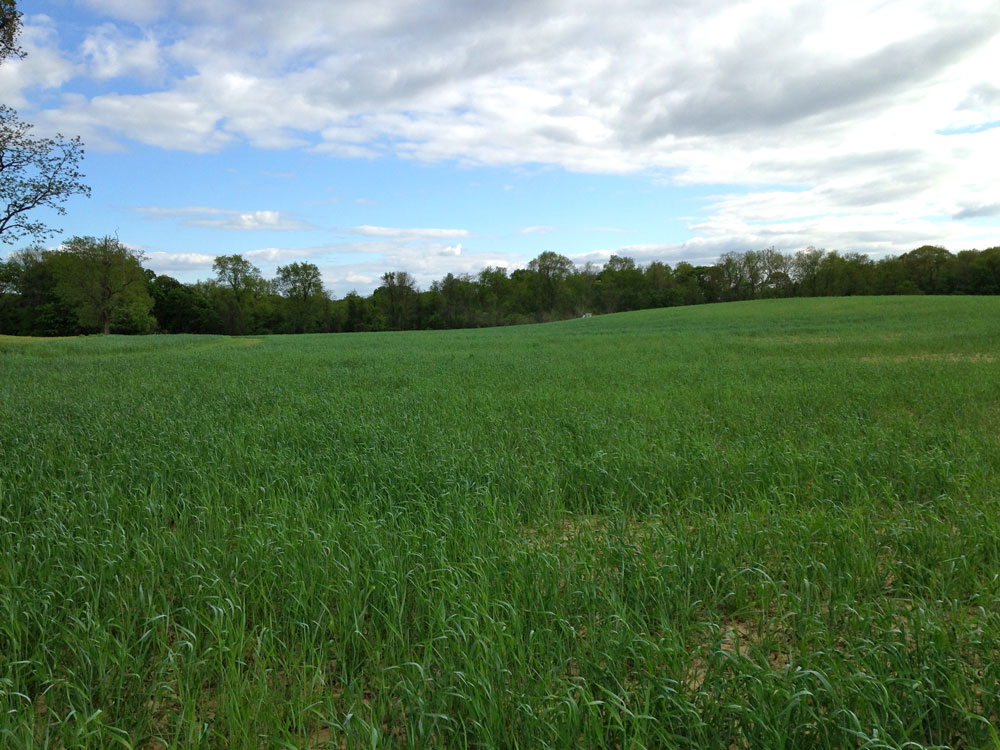
By mid-May the rye experienced a growth spurt
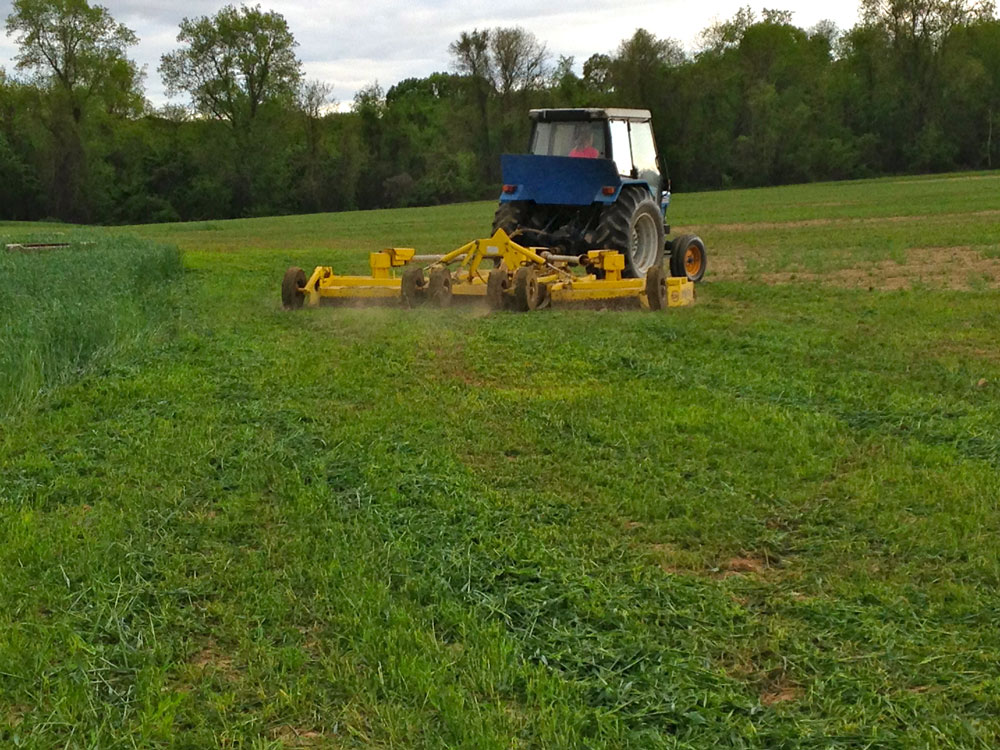
Rye being mowed on May 13, 2015.
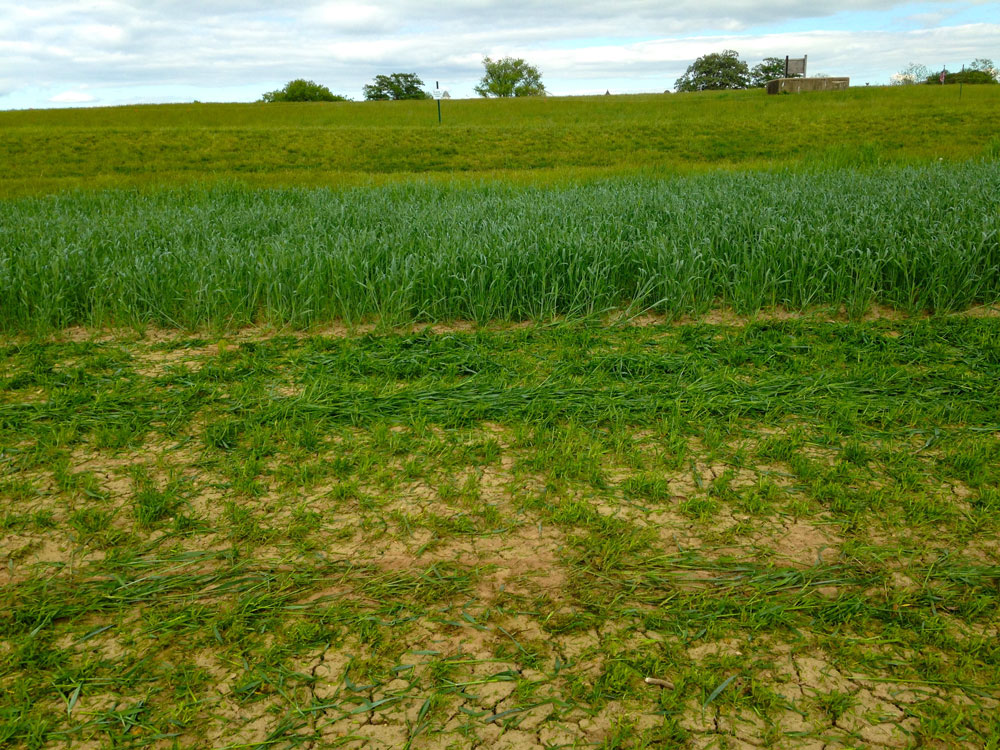
The mowed rye exposed the dry soil that was a result of low precipitation during the early spring.
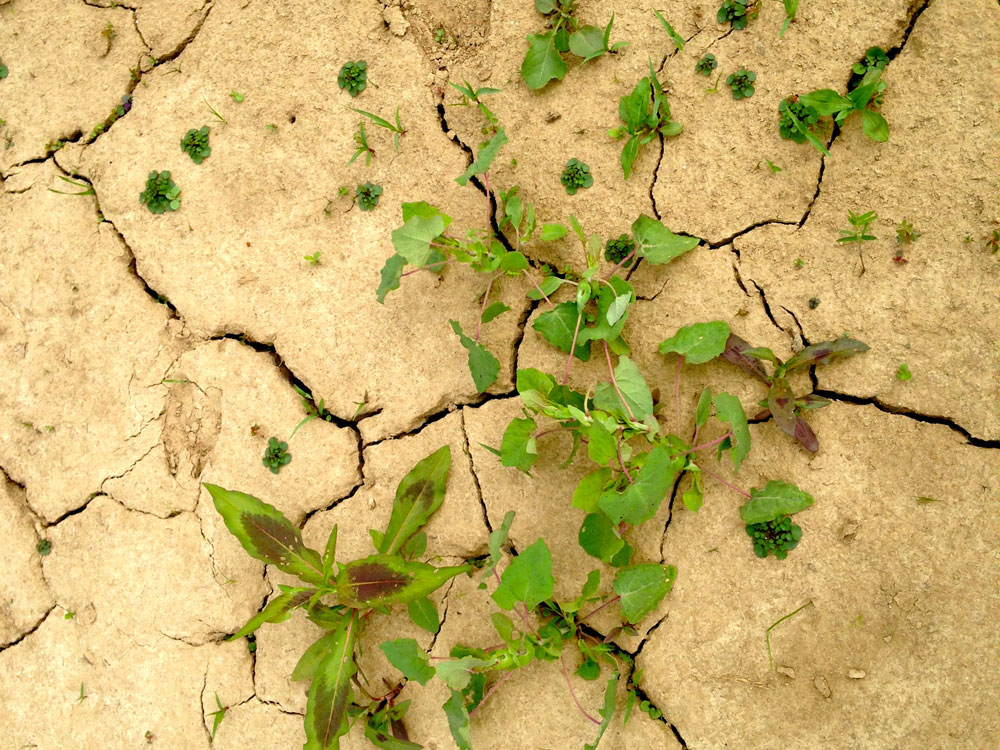
A close up of the soil in the northern section of the field in mid-May. The presence of Smartweed and Mile-a-Minute surviving these harsh conditions were a troubling omen for this area.
Re-grading the northern section of the field.
Within 5 to 7 acres on the northern section of the field, three separate areas continued to erode over the 2014-15 winter. This continued erosion along with prior erosion events resulted in a sparse rye crop compared to the rest of the field. Where possible the area was mowed but still required re-grading before planting with native seeds. RVC, a local landscape company from South Huntington did an excellent job grading the area in one day.
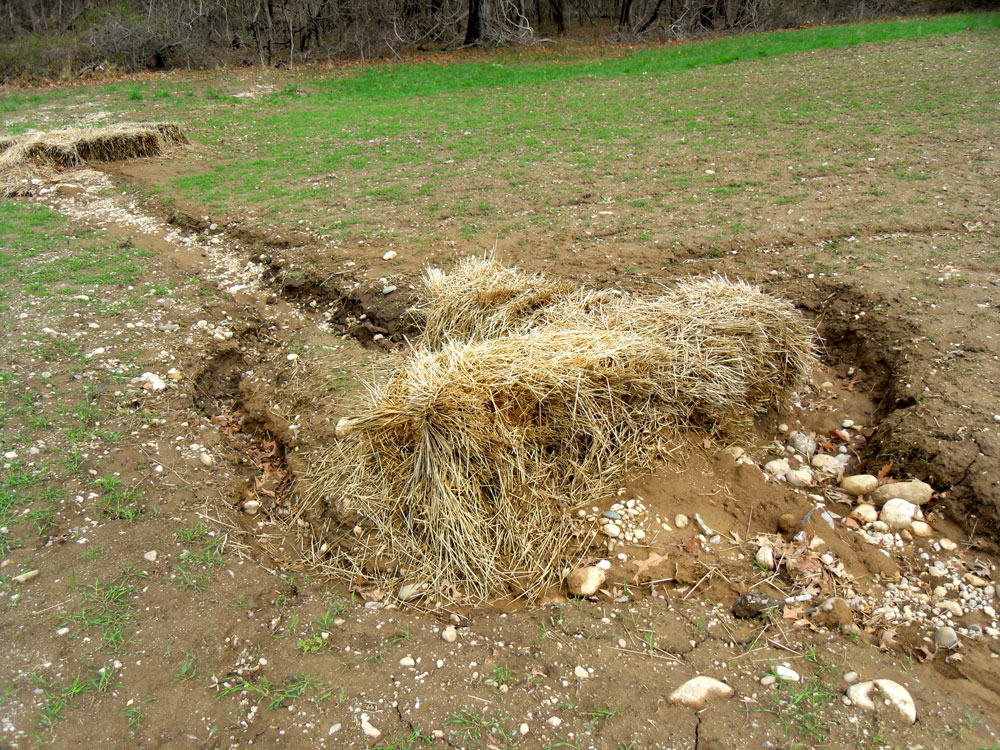
Hay bales and rye were not enough to stabilize the soil back in the fall of 2014.
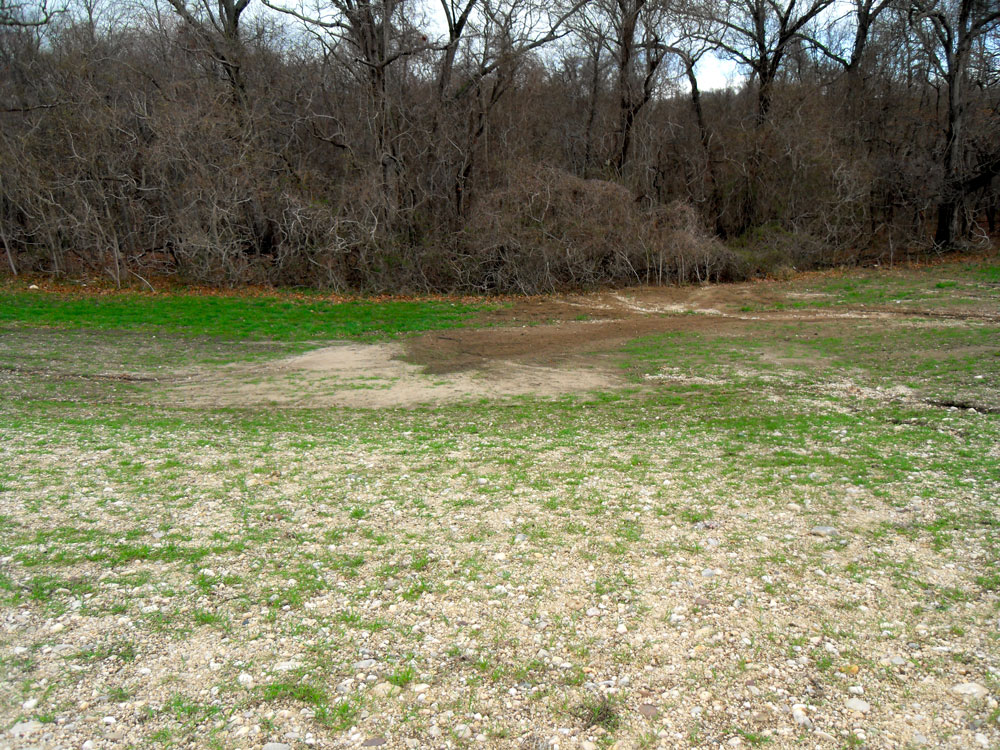
The foreground of this photo shows the sandy and rocky soil that was left as a result of erosion. The eroded soil settled near the base of the field and was recovered as part of the re-grading work.
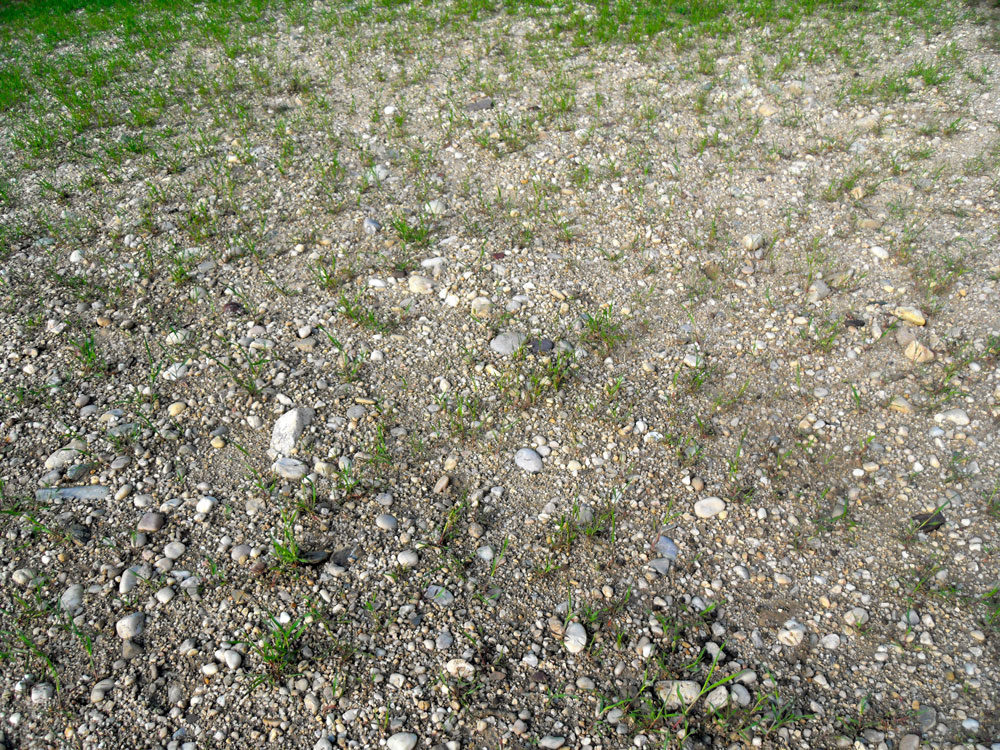
Close-up view of the rocky and sandy soil that was left after the area eroded.
Seeding the native grasses and wildflowers
On 22 and 26 of May 2015, a total of 403 pounds of Pure Live Native Seed was purchased from Ernst Conservation Seed Company and planted at a rate of approximately 13 lb per acre. Quantities per species were based on recommendations of Suffolk County Soil and Water Conservation District. The composition of the seed was 85% grasses and 15% wildflowers. Grasses include Big Blue Stem, Little Blue Stem, Indian Grass and Switch Grass. Wildflowers include Black-eyed Susan, Oxeye Daisy, Common Milkweed, Butterfly Milkweed and Slender Mountainmint.
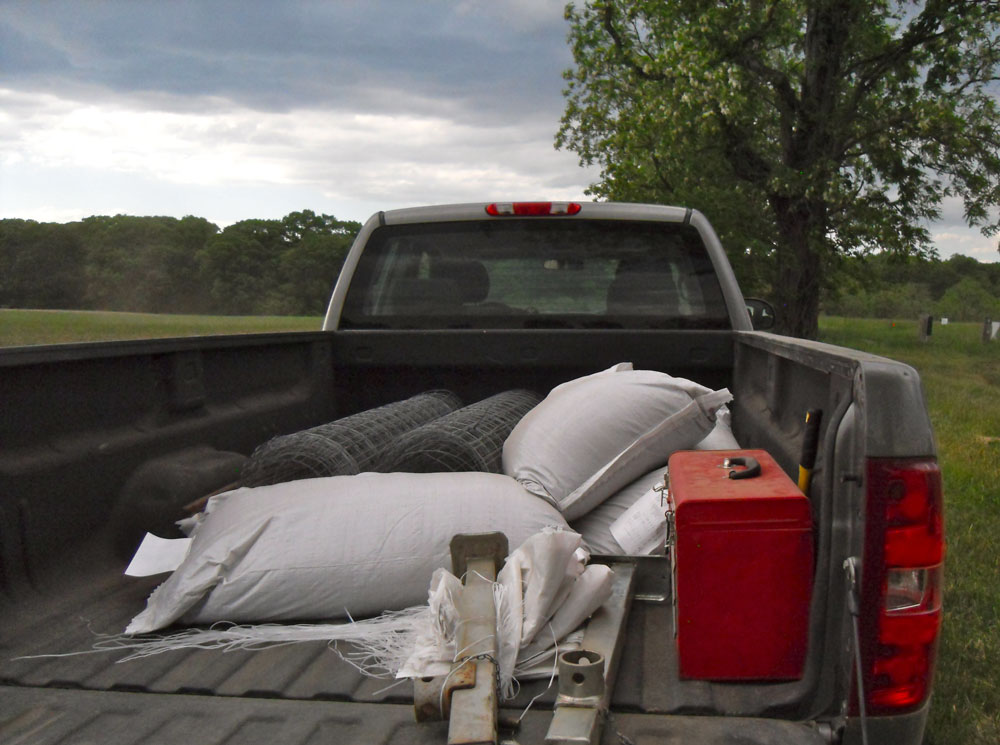
Seeding - May 2015
The field was seeded over 2 full days using a Truax No Till Drill borrowed from the US Fish and Wildlife headquarters in Shirley, NY. After the seed drill was transported to Caumsett, Chip Hamilton of NYSDEC calibrated and operated the drill.
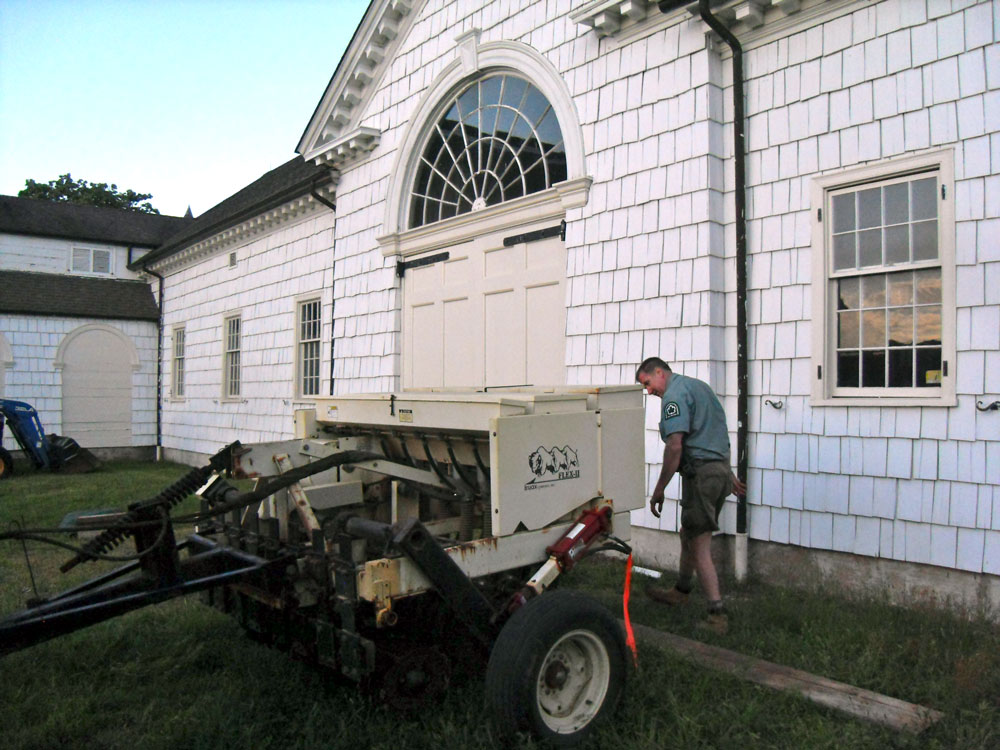
Truax No Till Drill at Caumsett
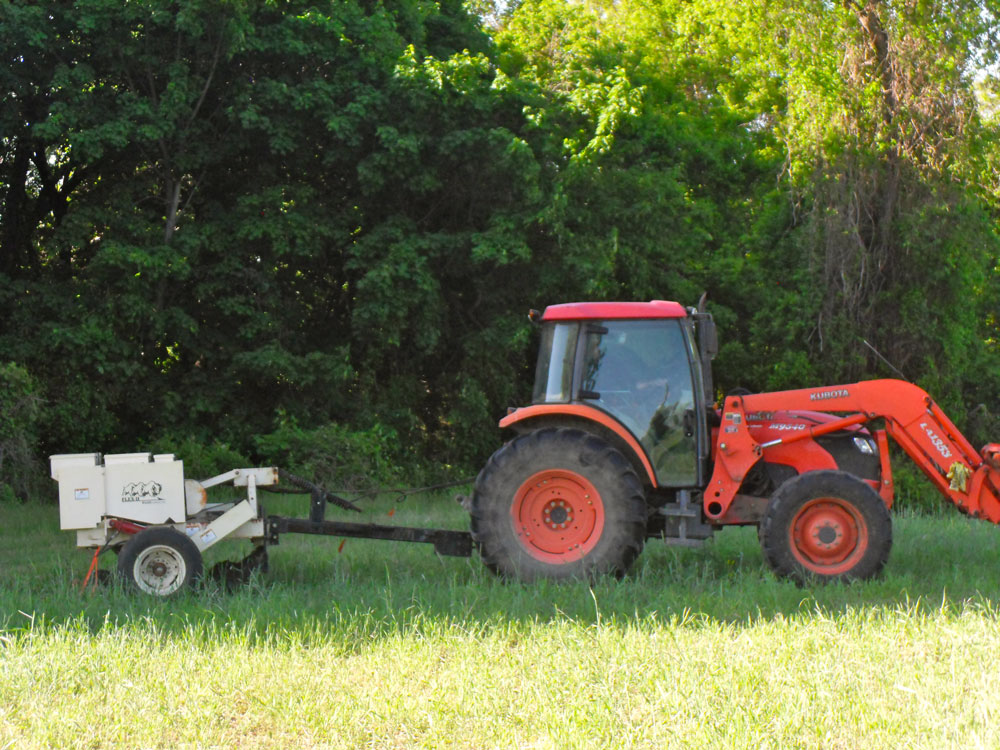
Drill operating in the field
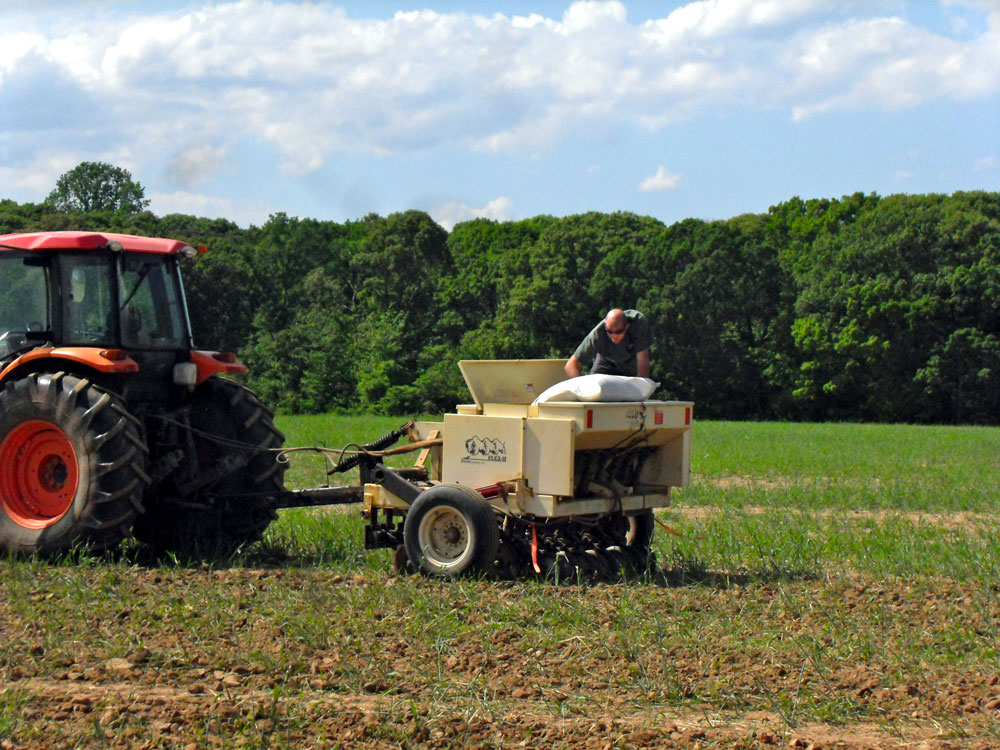
Seed being loaded into the drill's seed boxes
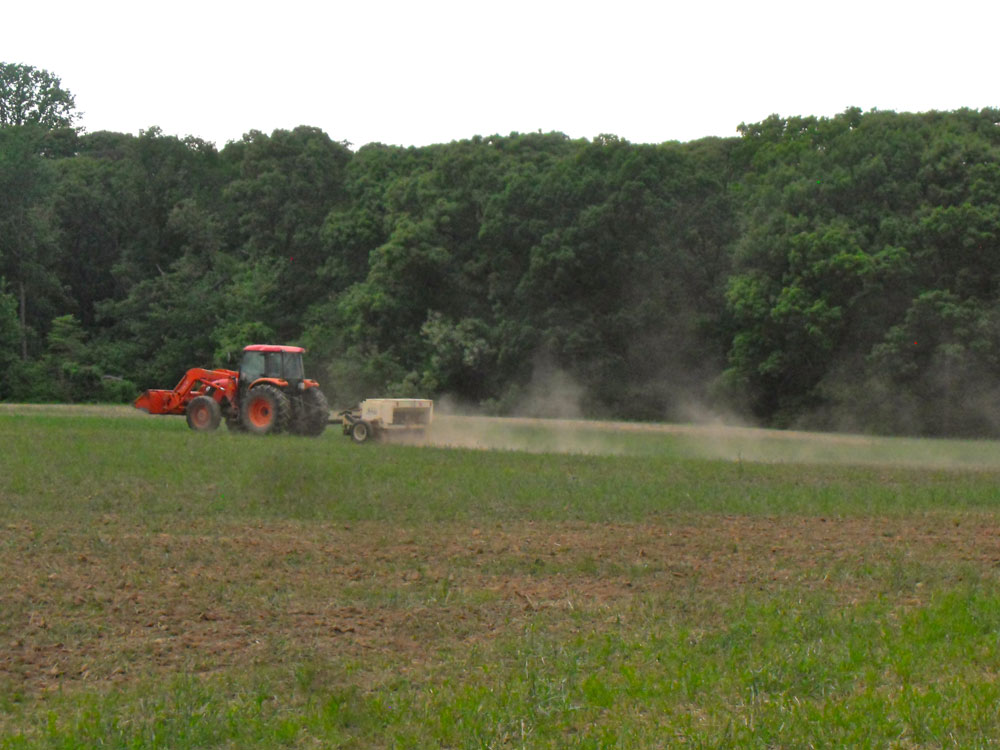
Seeding the field
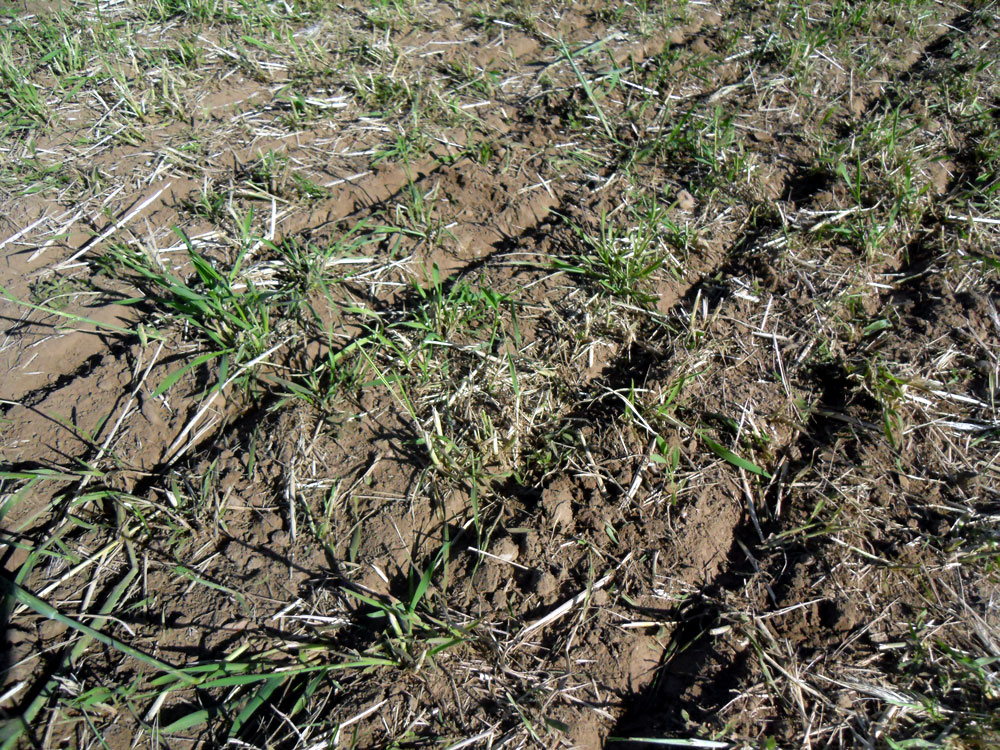
Tracks made by seed drill
Erosion Control
On June 8, 2015 , a local contracting company RVC installed ten 225' X 4' rolls of biodegradable burlap cloth to help prevent future erosion.
To further insure against erosion, twelve rolls of 4’ X 225’ jute cloth were installed in areas that had suffered serious erosion after the record breaking August date 2014 rainfall. This installation occurred after the fields were seeded with the native mix and proved to be successful in preventing future erosion. One problem did occur when the field was mowed. The mower blade caught the cloth and ripped in out of the ground rendering the mower out of commission until the cloth could be cut off the blade. This problem was avoided when the mower operator raised the height of the blade in the areas where jute had been installed.
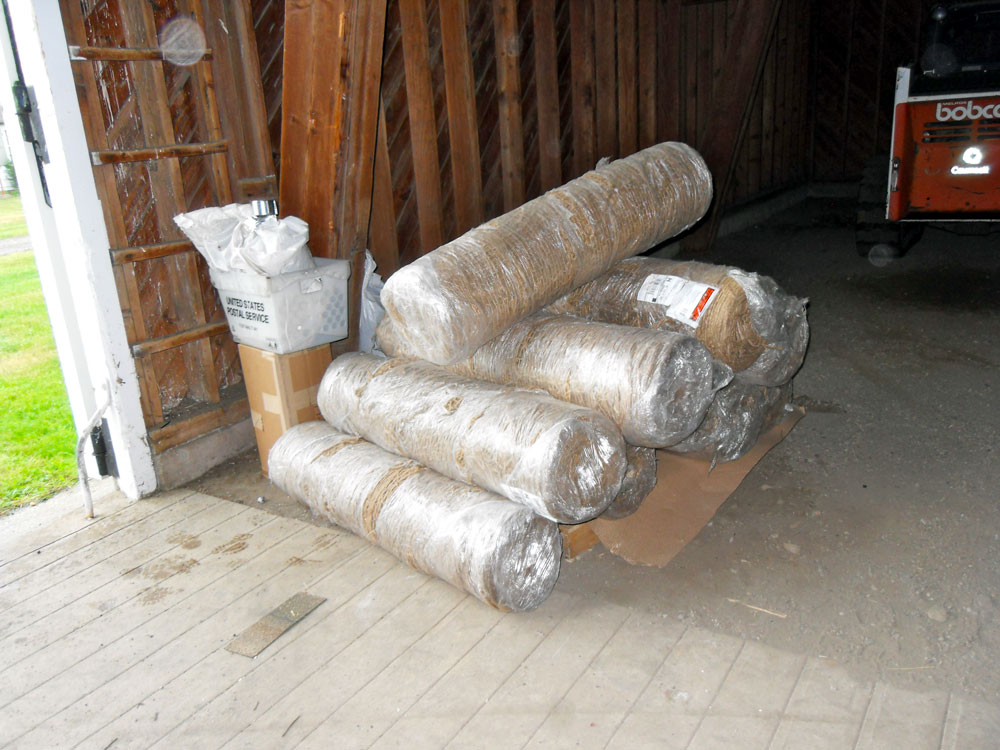
Jute cloth in barn
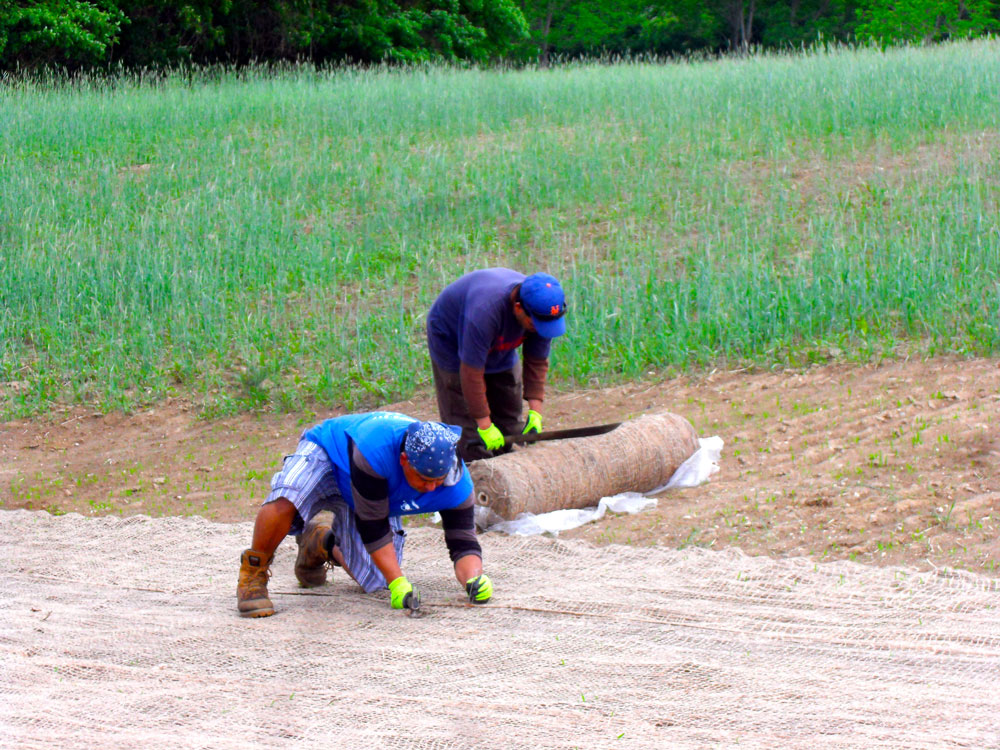
RVC installing jute
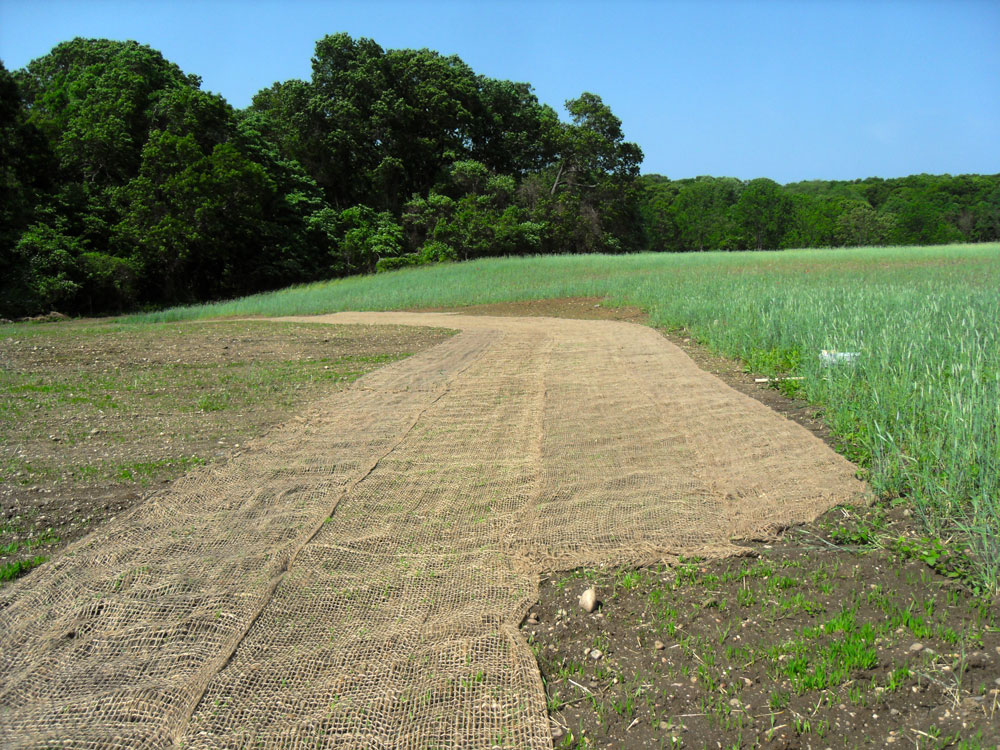
Jute cloth on hill side
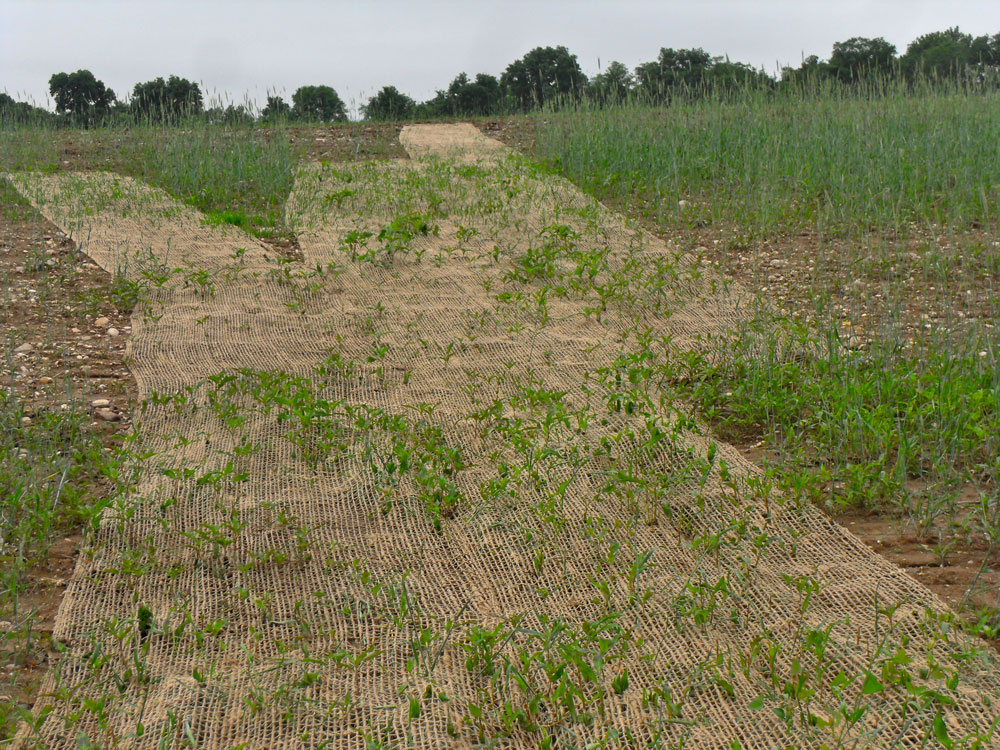
Jute with oats growing
The 2015 Growing Season
Following the planting of native seed a predictable weed flush emerged in June and continued through out the summer. In order to manage this flush the field was mowed to a height of 4 to 8 inches when the vegetation reached 18 inches preventing some of the weeds from going to seed. Timely mowing was not always possible due to equipment breakdowns and staff availability therefore future weed seed germination is anticipated.
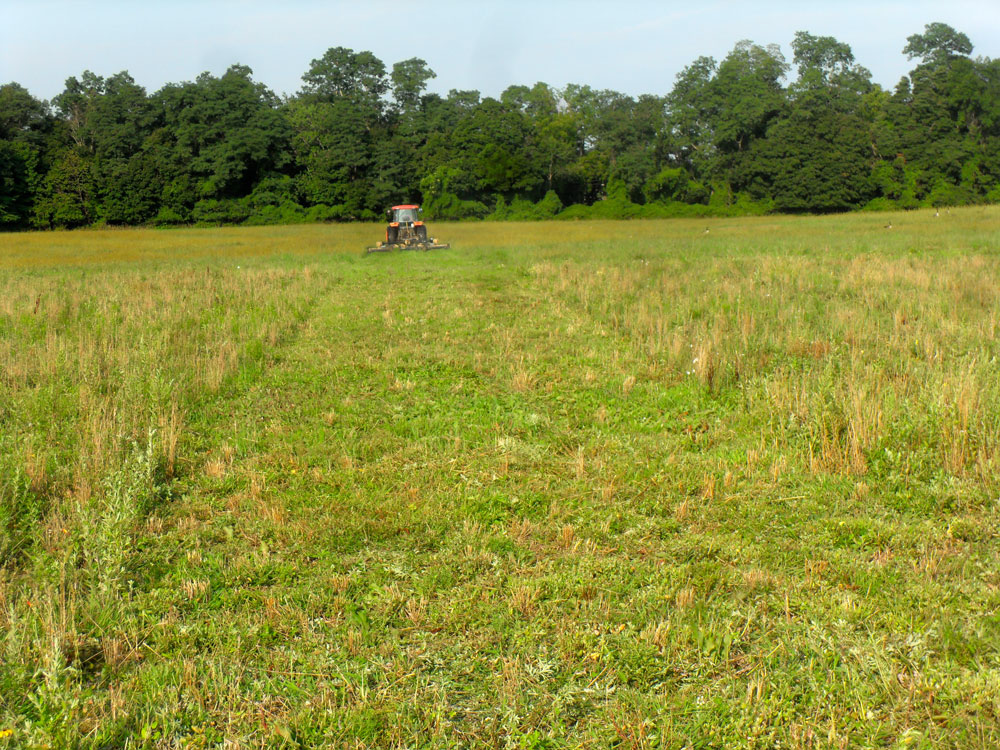
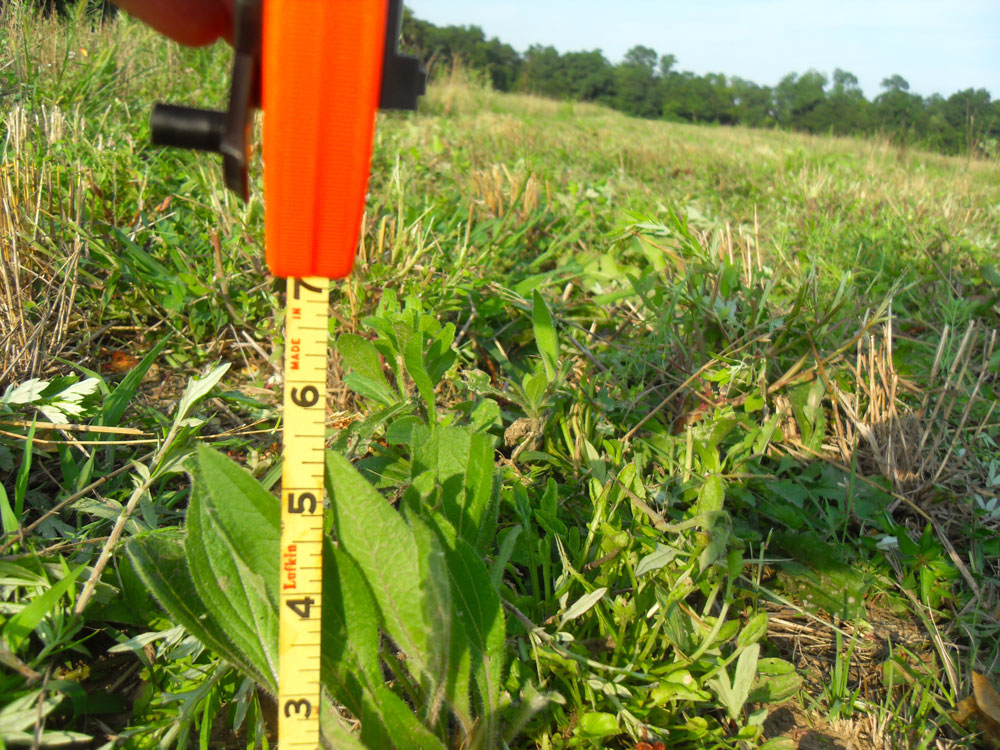
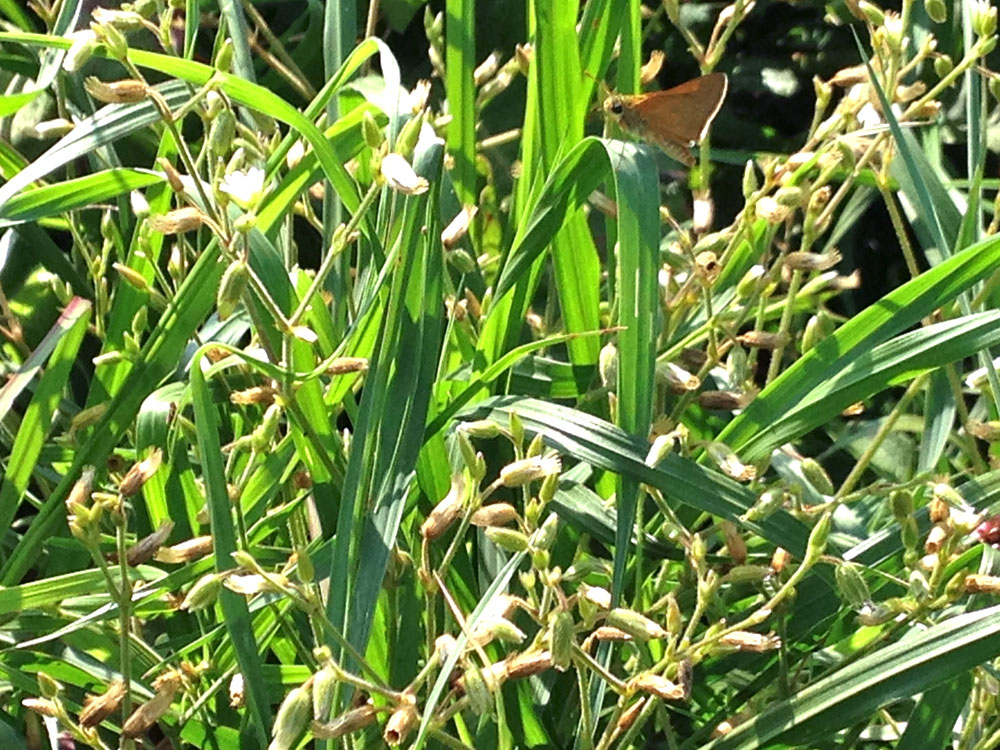
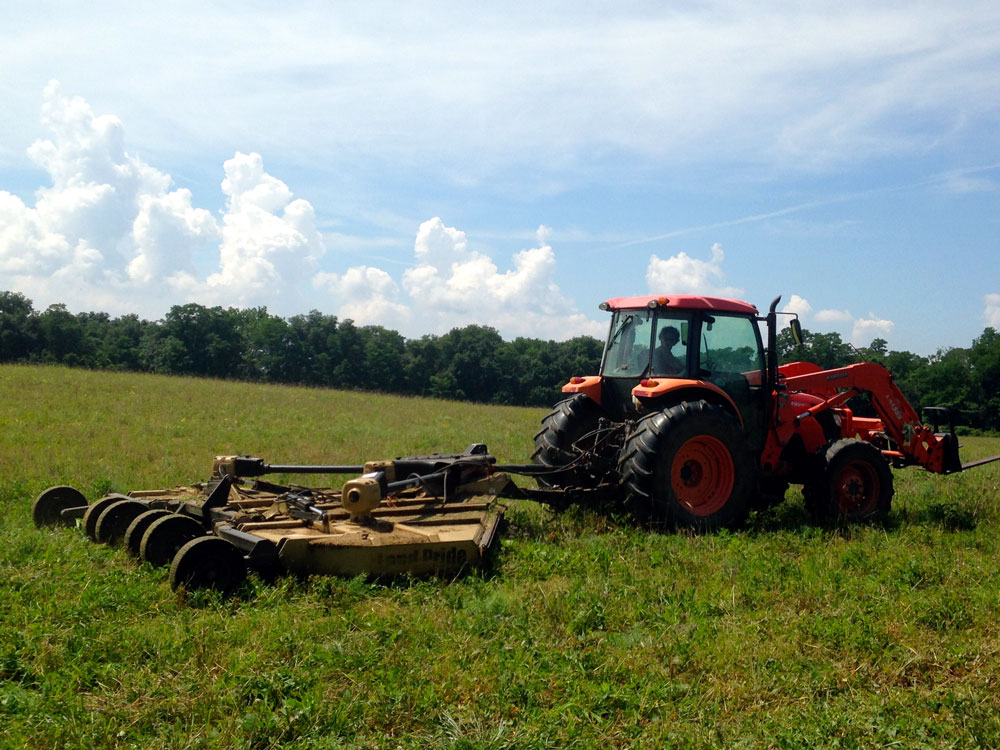
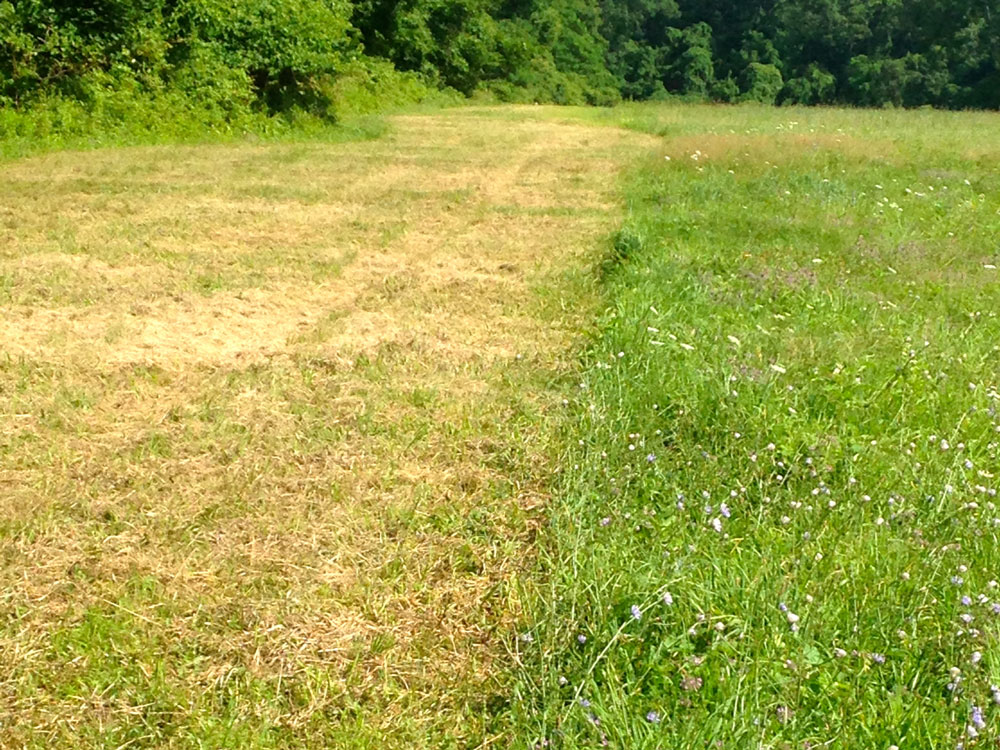
Mile-a-Minute (MAM) Problems
An unanticipated problem was the emergence of a dense stand of Mile-a-Minute (MAM) located near the center of the site. A great deal of time and effort was used to physically remove this invasive plant including extracting with hand tools, weed whacking, tarping and raking. Two types of tarping were applied to the MAM areas for a period of approximately 3 months: a 1.5 mil clear polyethylene sheet and a standard roofing tarp. Each tarp was trenched in place and soil temperatures were recorded. Deer hooves were able to pierce the polyvinyl sheeting making it less effective in killing the MAM. The standard roof tarp was not damaged by deer hooves and successfully killed the MAM. Soil temperatures under each tarp were taken through out the summer. The high temperature reading occurred on 26 July when a reading of 101 ℉ was taken under the roof tarp and 102 ℉ under the clear polyvinyl sheeting.
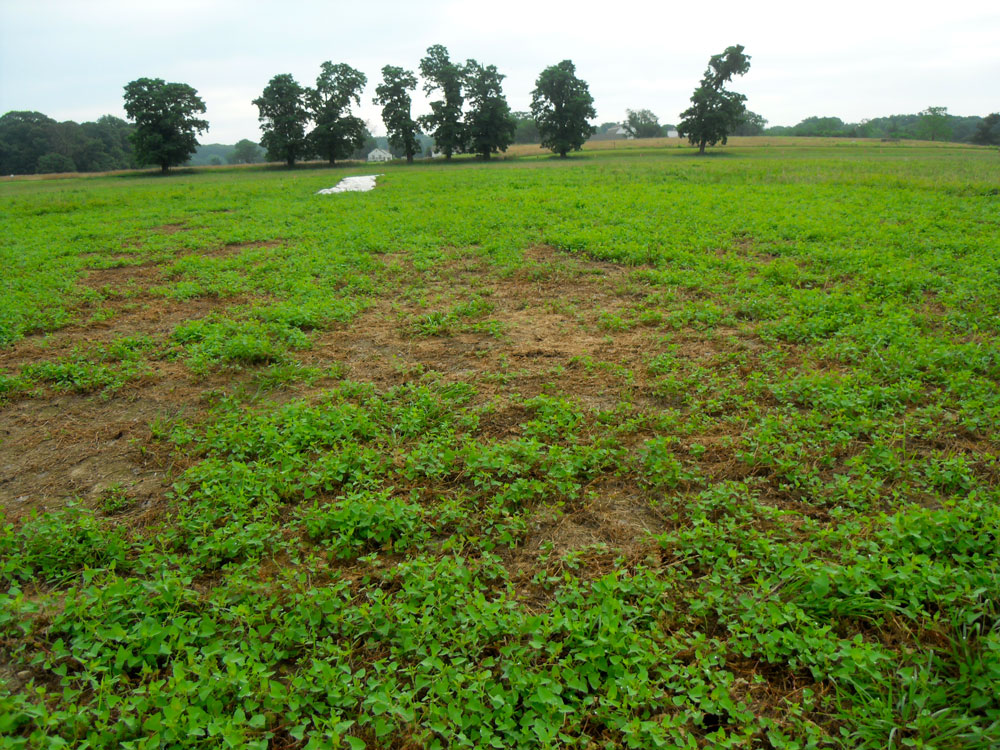
Large area of MAM located near the center of the restoration site.
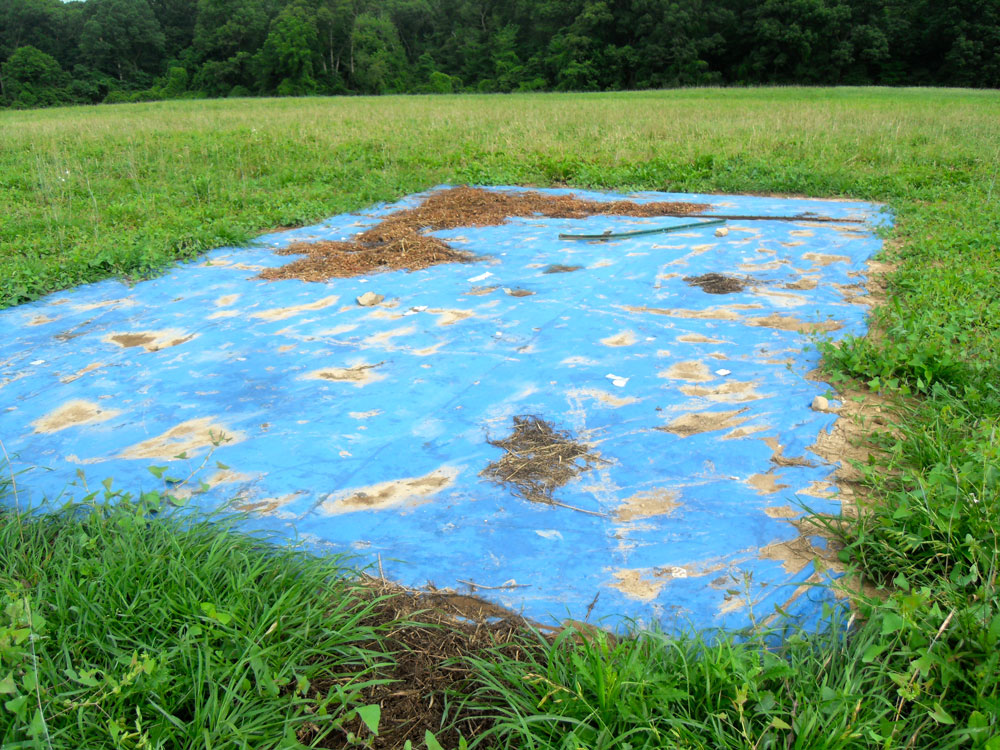
Tarped MAM using a large roof tarp.
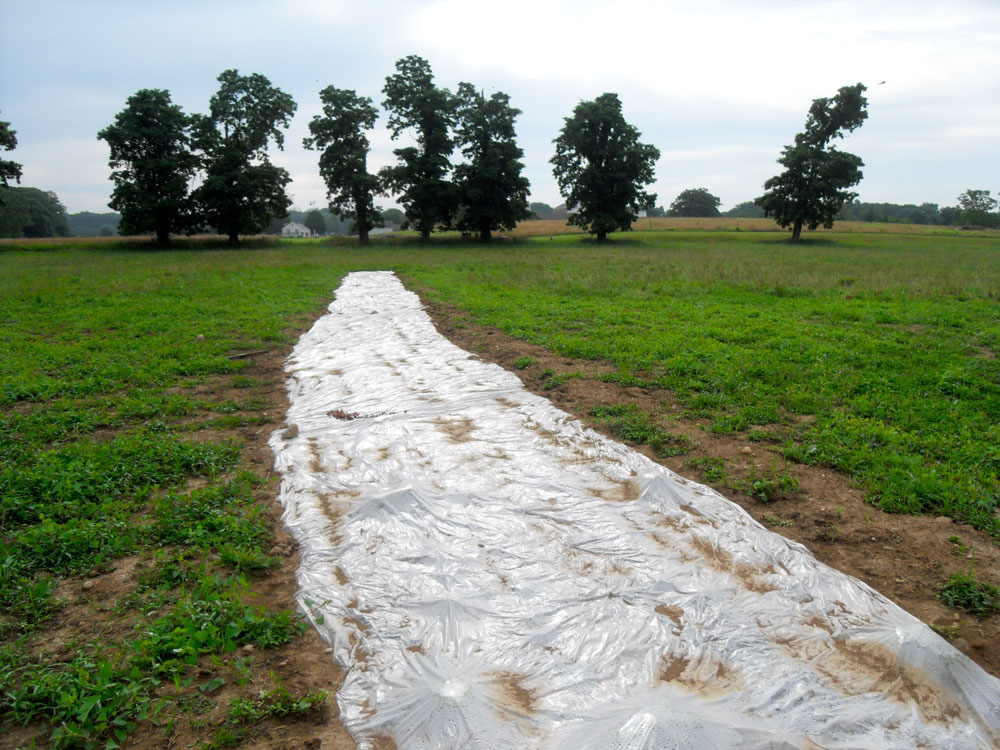
Tarped MAM using clear thick polyvinyl sheeting.
In late July and early August MAM was easily raked out of the soil once it grew about one foot in length. A 16 Tined Bow rake was used to rake the MAM into piles. MAM and all pulled invasives plants were placed into black garbage bags and left in the sun for a minimum of 3 weeks..
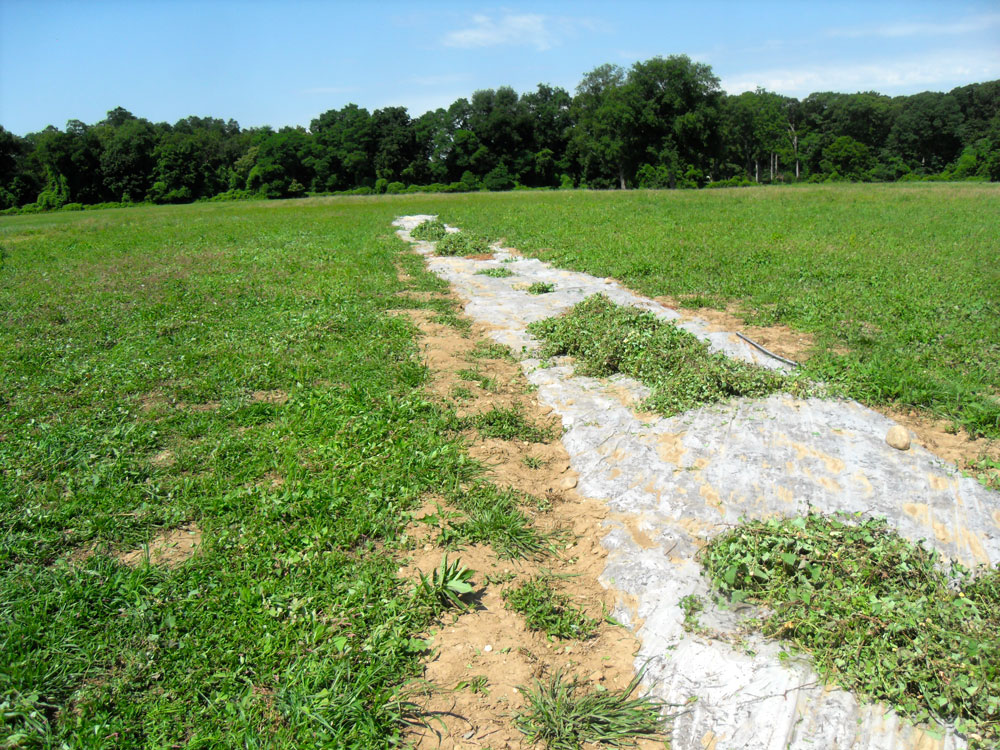
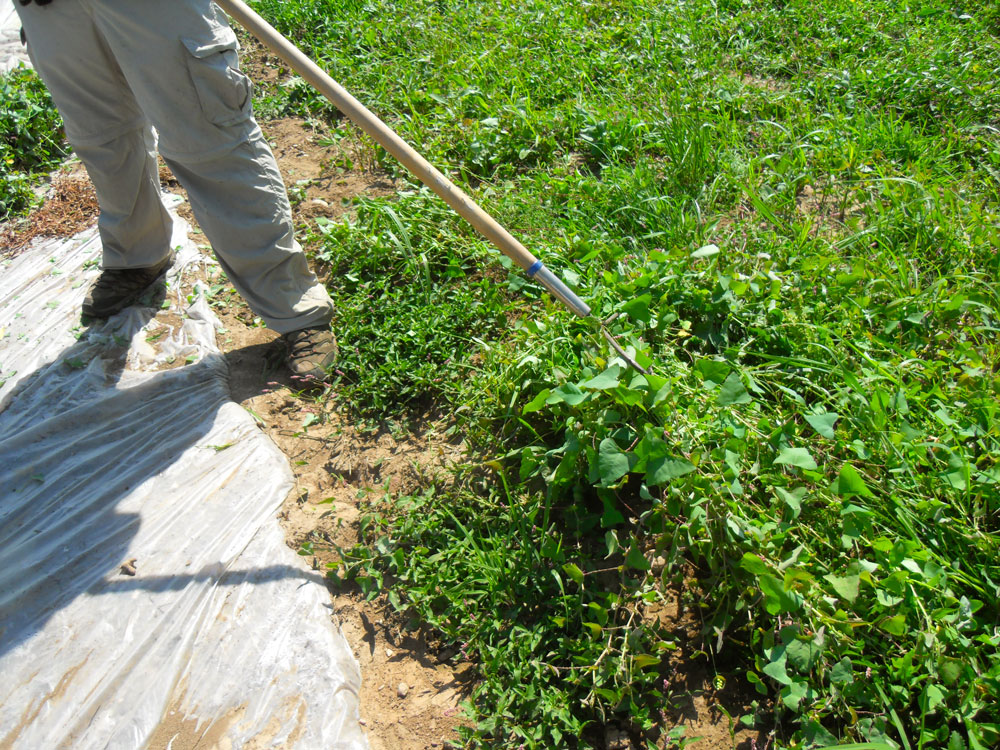
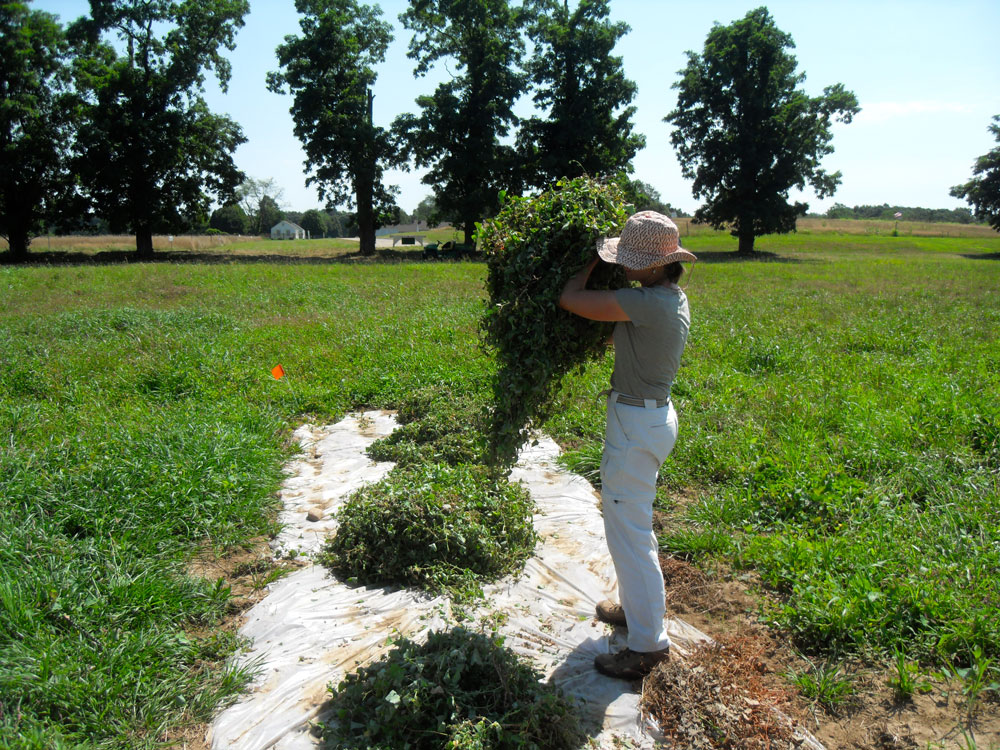
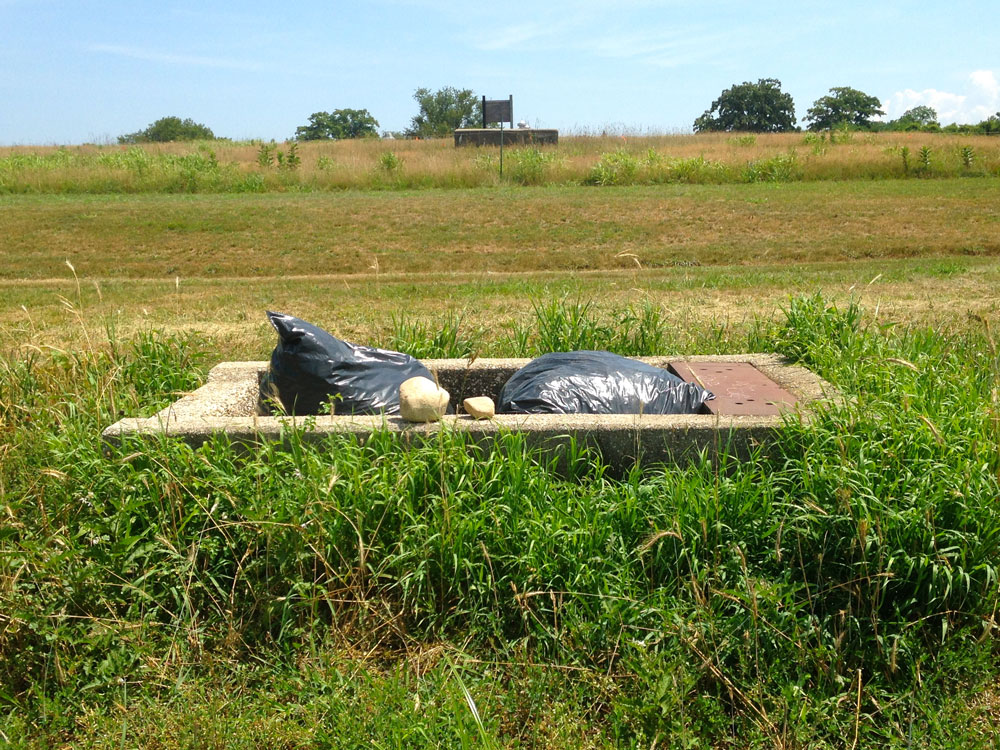
In addition to MAM, dense stands of Smartweed, Clover, Curled Dock and Crab grass covered some areas interfering with germination of the native seed. When possible these areas were weeded and/or weed whacked to open up the vegetation cover.
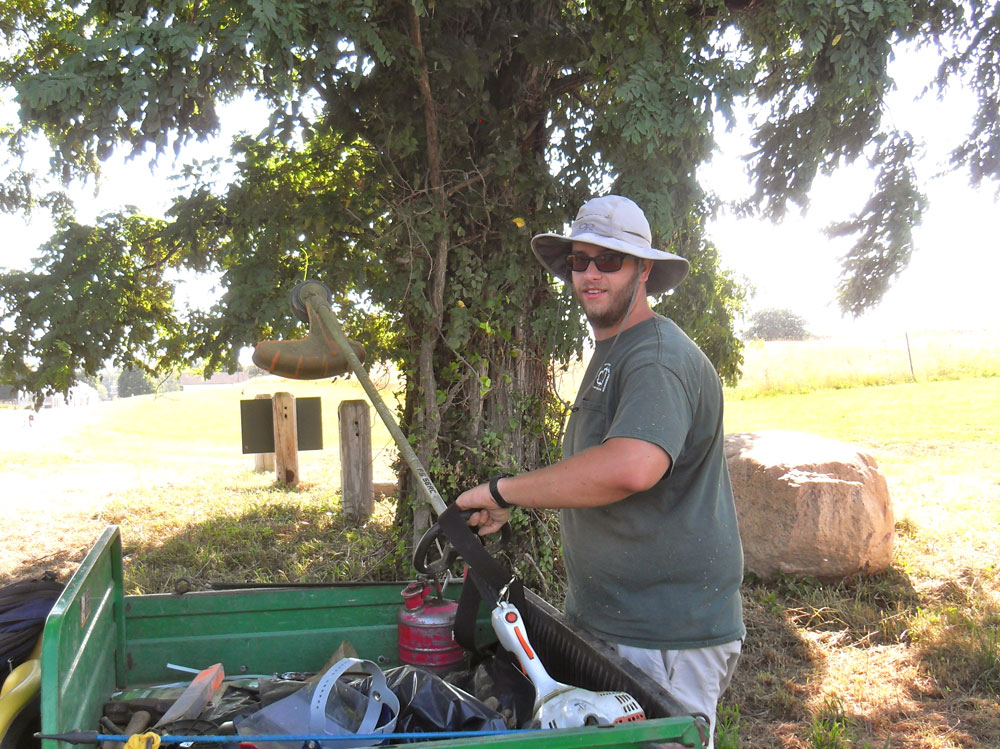
2015 Summer Intern unloading weed control equipment
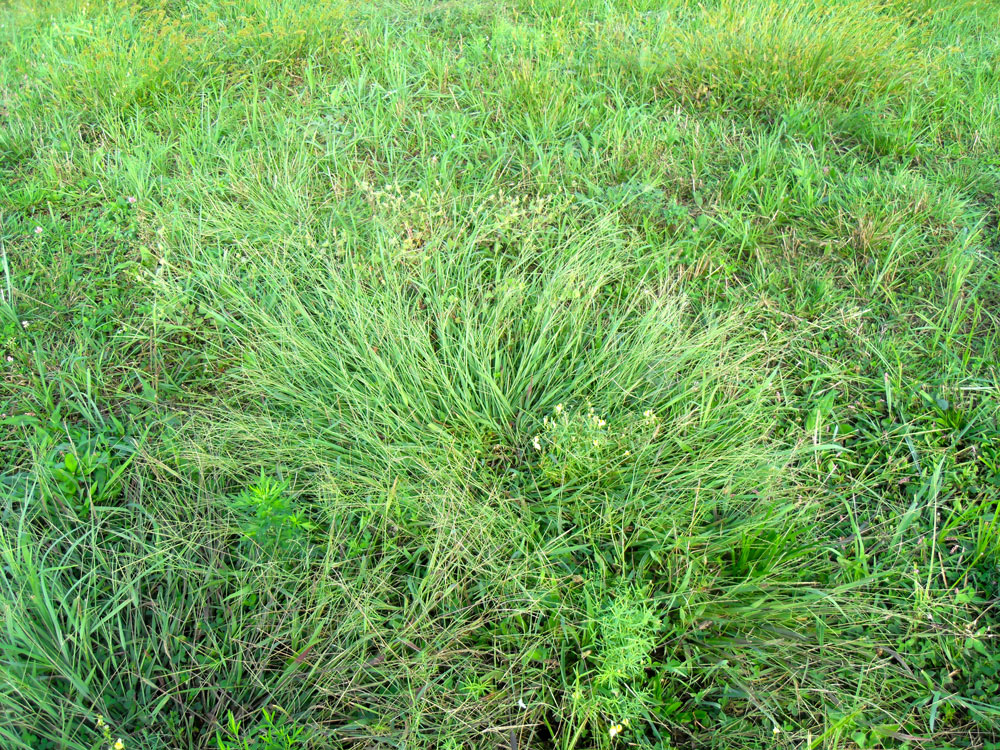
Crabgrass, seen in the center of the photo, is an Annual Grass that grows in a circular pattern and can shade out the native seed underneath it.
The 2015 Fall Season
By early September warm season grasses (WSG) could be seen emerging within the seed drill tracks and the following month most had reached a height between 4 and 6 inches. In mid September three of the WSG species had reached a height of over two feet with flowers thereby allowing them to be identified as Big Blue Stem, Switchgrass and Indiangrass. Small patches of these grasses were present mainly in the south and central sections of the field. In October, Little Blue Stem could be identified by flower. During the first growing season WSG direct most of their energy into establishing an extensive root system. While the vast majority of the Caumsett Restoration WSG appeared to be forming root systems it was encouraging to find a small percentage of all four species that had flowered and gone to seed. The final mowing of the field took place on September 26 resulting in a heavy layer of cut vegetation (thatch) on the field. For several days the thatch was raked and bagged however a good deal of it was left on the field until Spring of 2016.
Mid-September Progress
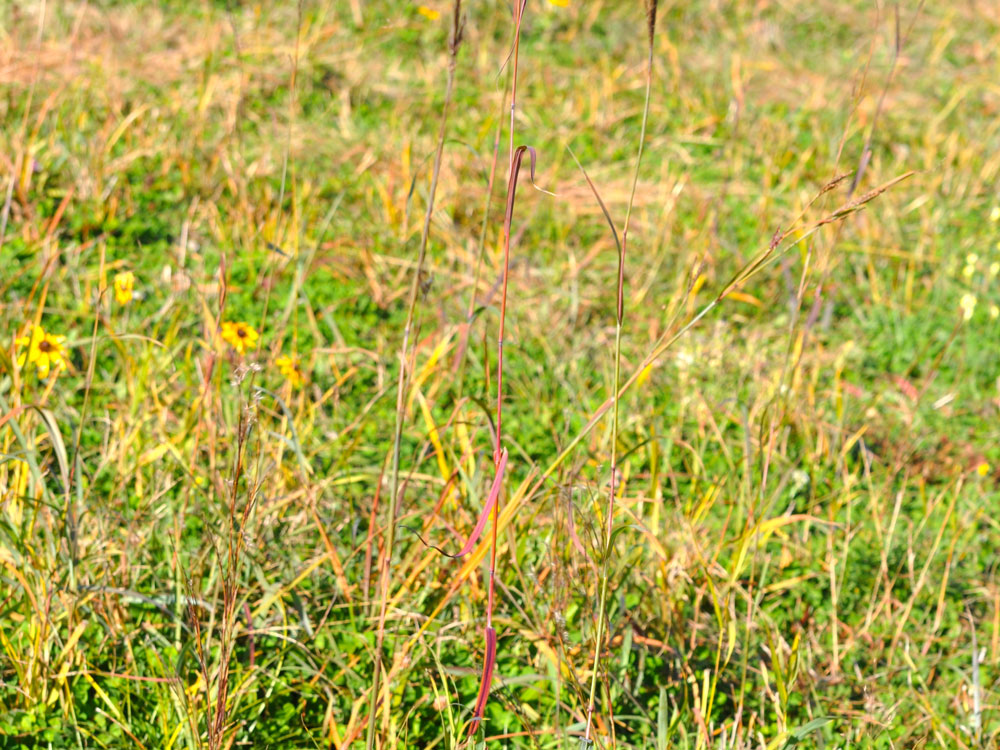
The dark purple seed heads of Big Blue Stem could be seen growing in the dense clover.
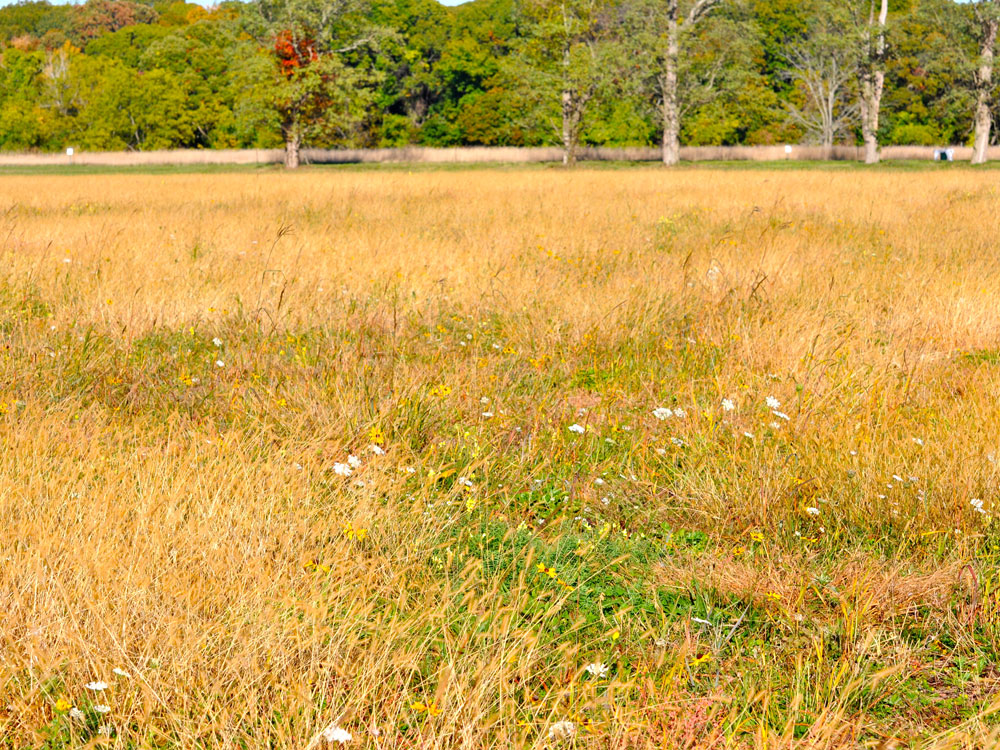
A mix of vegetation including Foxtail (Setaria glauca), Black-eyed Susan and Queen Anne's Lace can be seen in the lower half of the photo. In the upper half of the photo the tall dark purple stems of Big Blue Stem can be seen. Foxtail, is an undesirable non-native annual which will be controlled by mowing before the seeds mature.
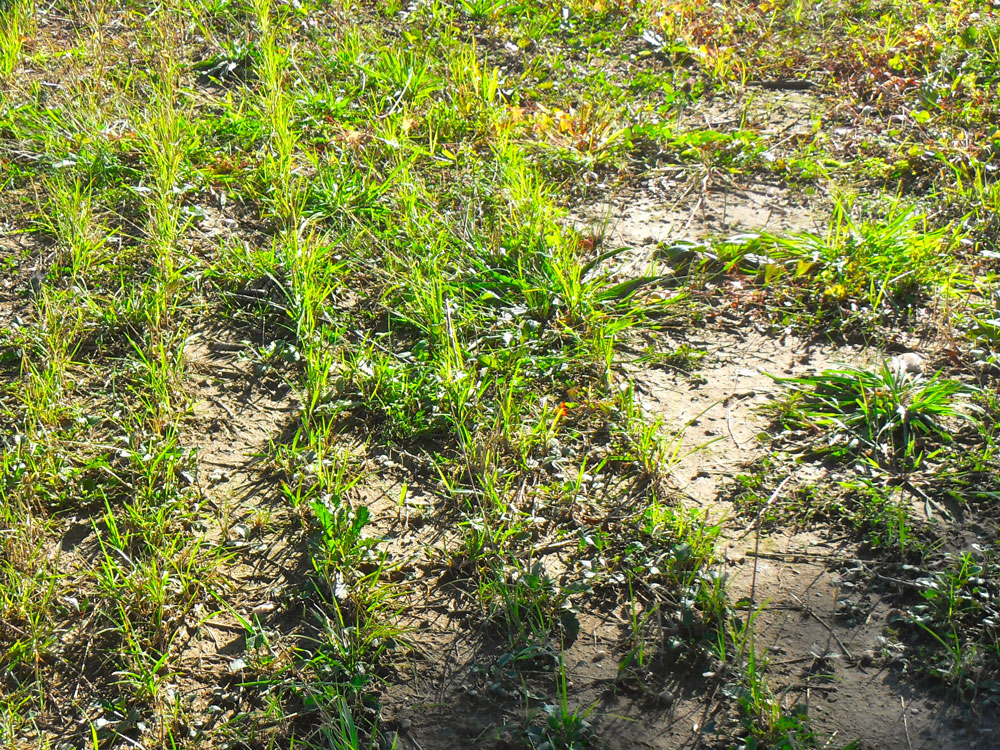
WSG growing in the seed drill tracks.
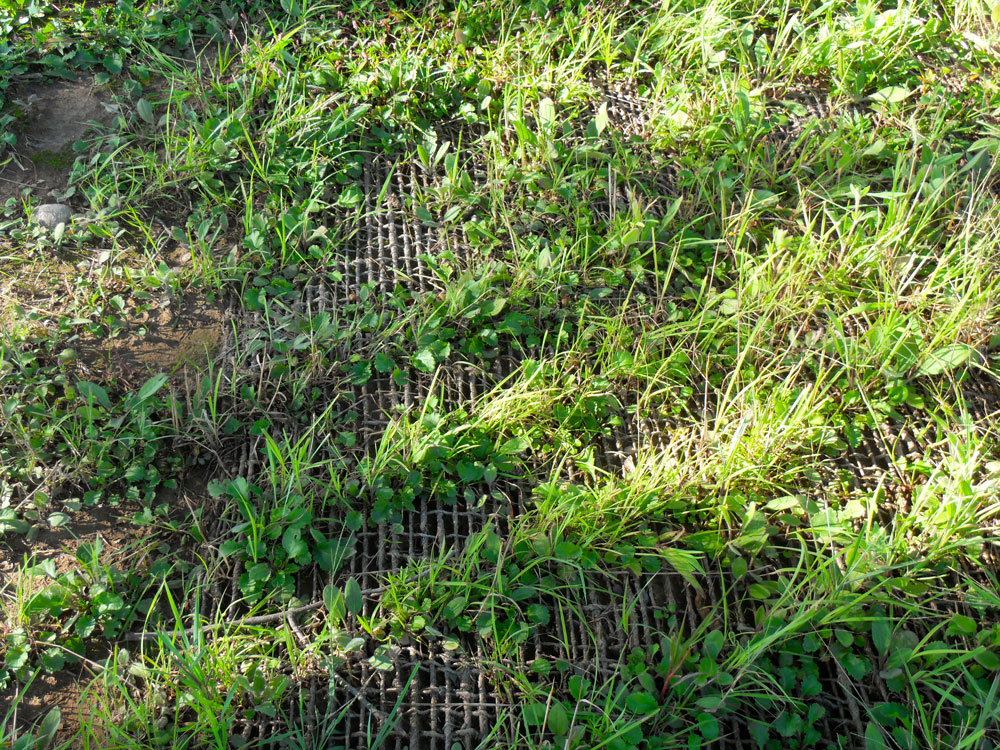
WSG and forbs growing in seed drill tracks within jute cloth installation.
Wildflowers
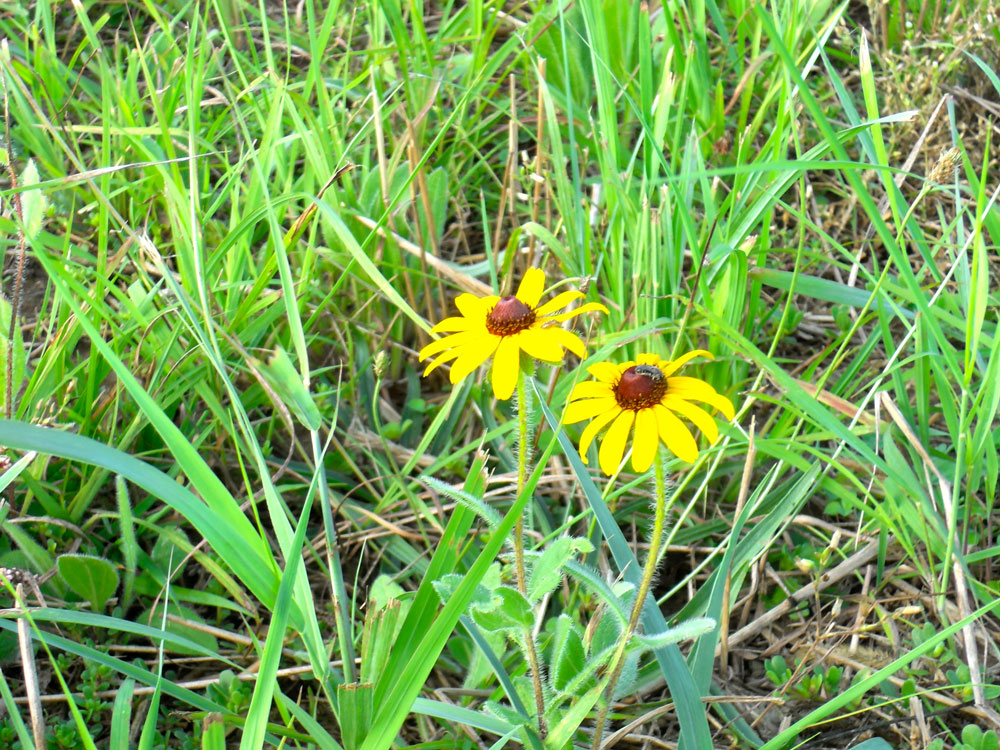
The flowers and basal leaves of the Black-eyed Susans (Rudbeckia hirta) were plentiful through out the restoration field. This was one of the five forbs that were seeded with the WSG.
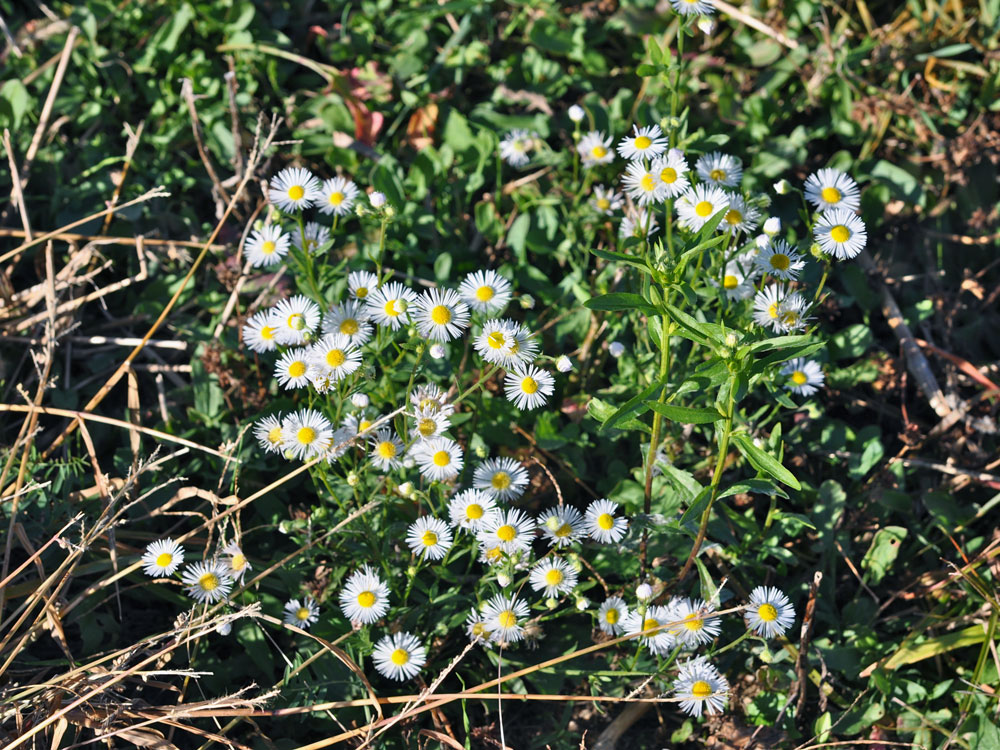
Eastern Daisy Fleabane (Erigeron annuus) Part of the old seed bank this lovely native emerged through out most of the restoration area.
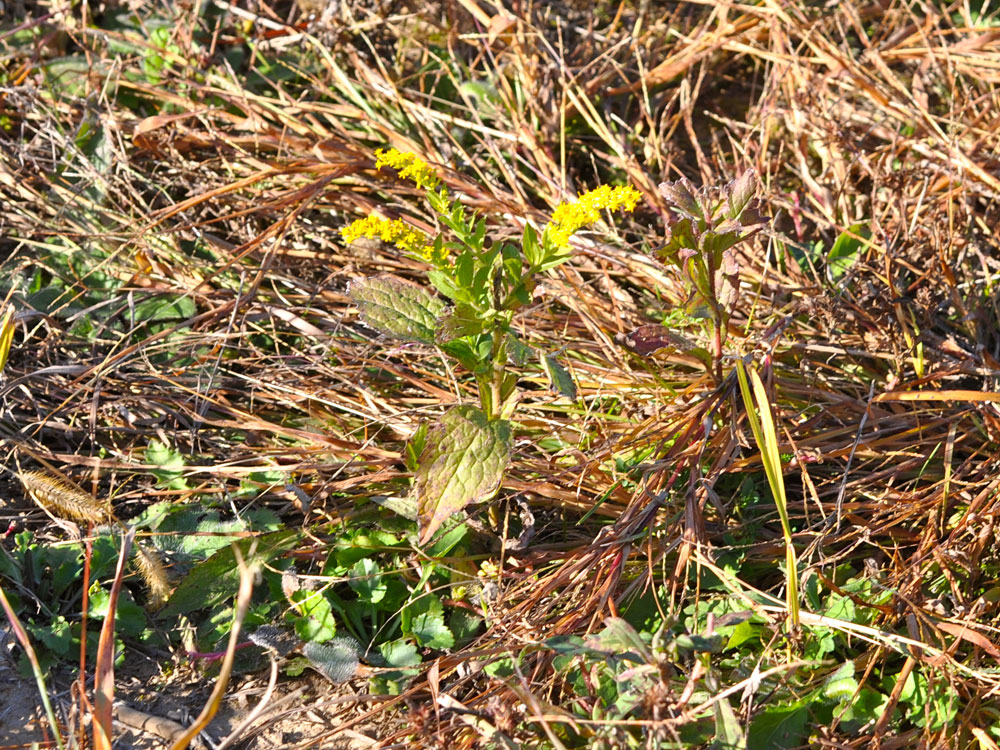
In the southern section of the field another volunteer that appeared in the late fall was Goldenrod. It was a surprise to find these plants no taller than 6 to 8 inches in flower!
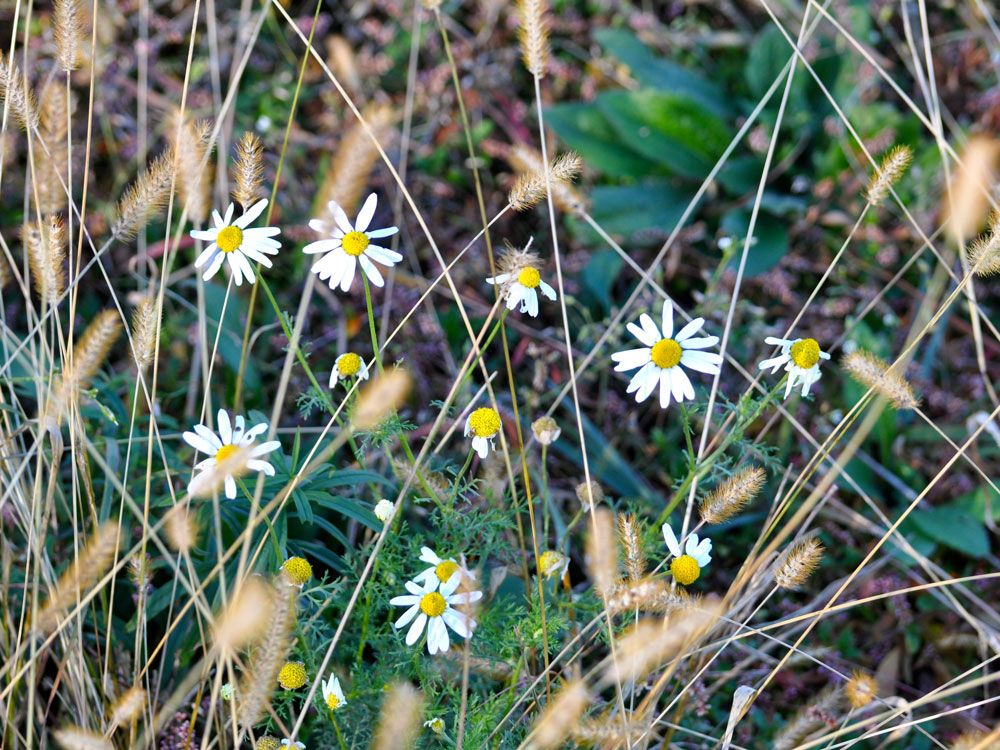
Oxeye Daisy (Chrysanthemum leucanthemum
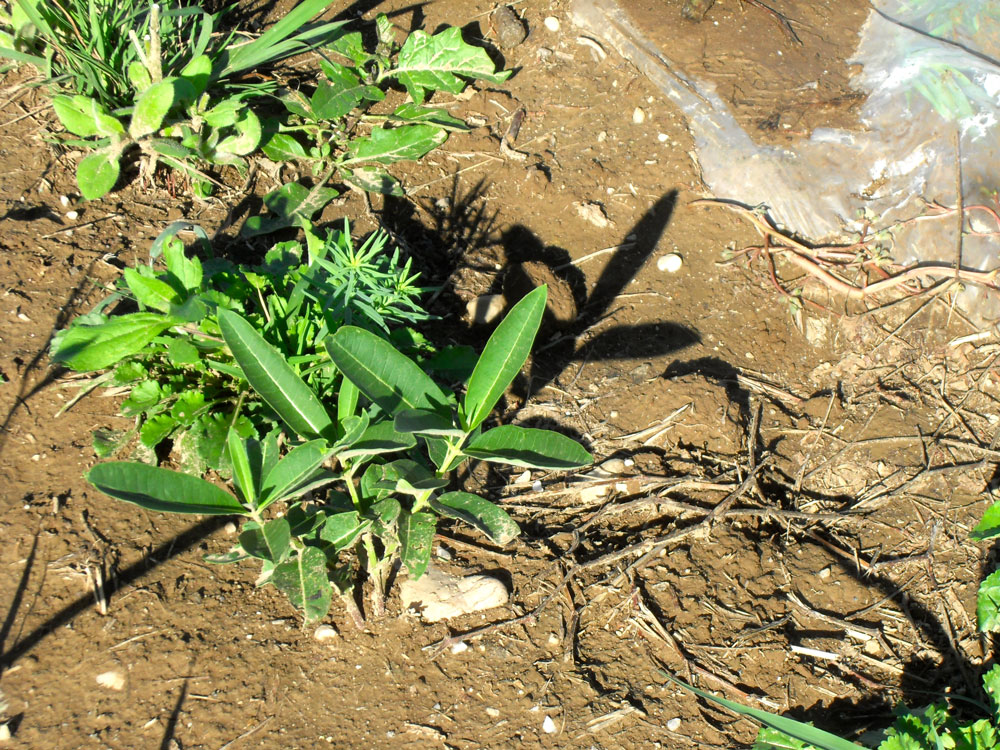
Common milkweed (Asclepias syriaca)
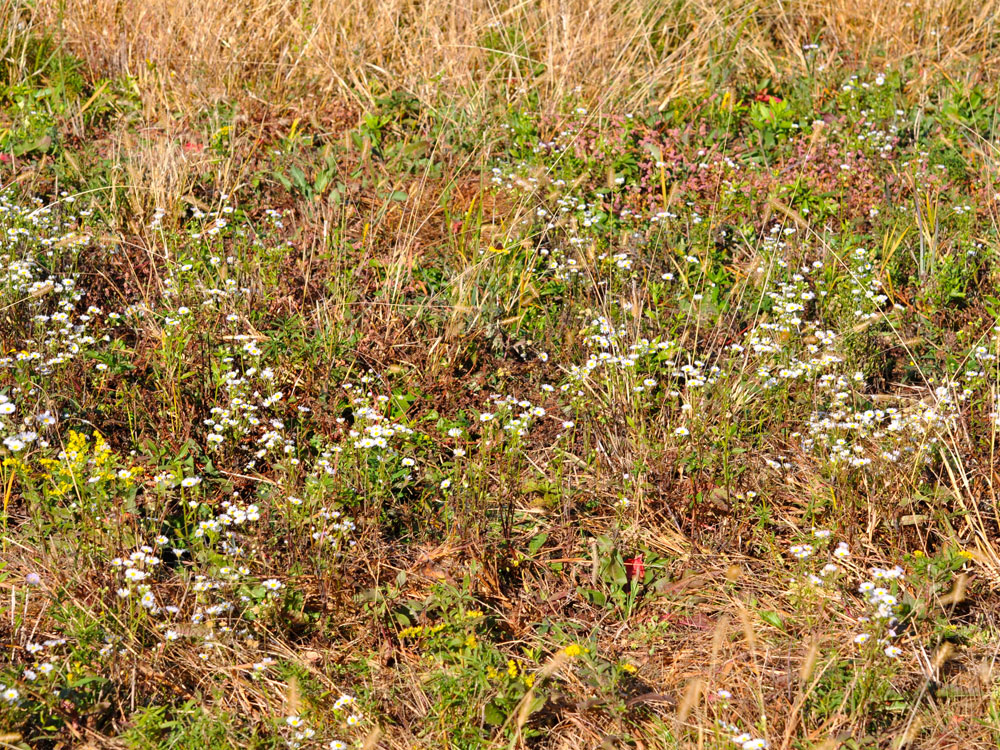
Mix of various forbs including Daisy Fleabane and Goldenrod.
Grassland Restoration Project Phases
- Project Overview
- Phase 1 - September through November 2011
- Phase "1.5" - Summer 2012
- Phase 2 - December 2012 through September 2013
- Phase 3 - March 2014 through Spring 2015
- Second Year of Establishment 2016
- Third Year of Establishment 2017
- Fourth Year of Establishment 2018
- Aerial Photos of Field
- Grassland Management Plan
